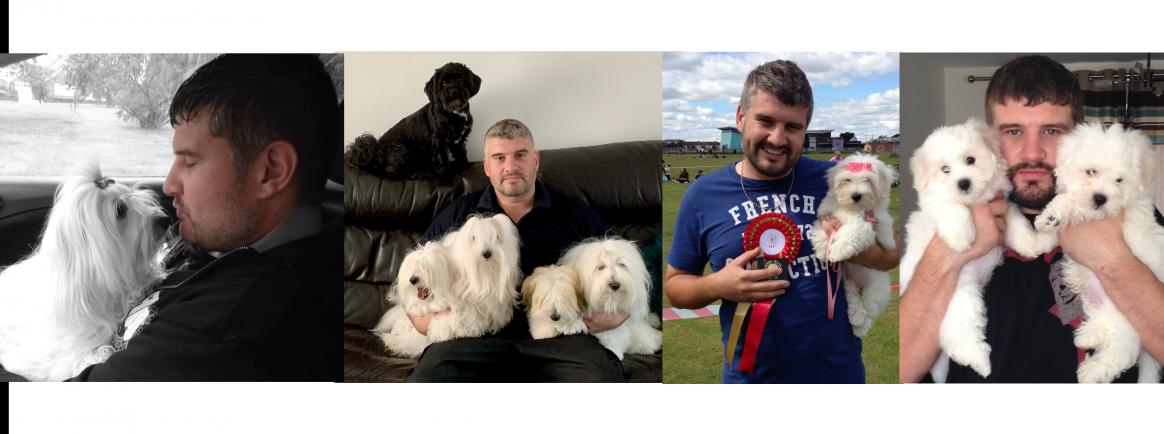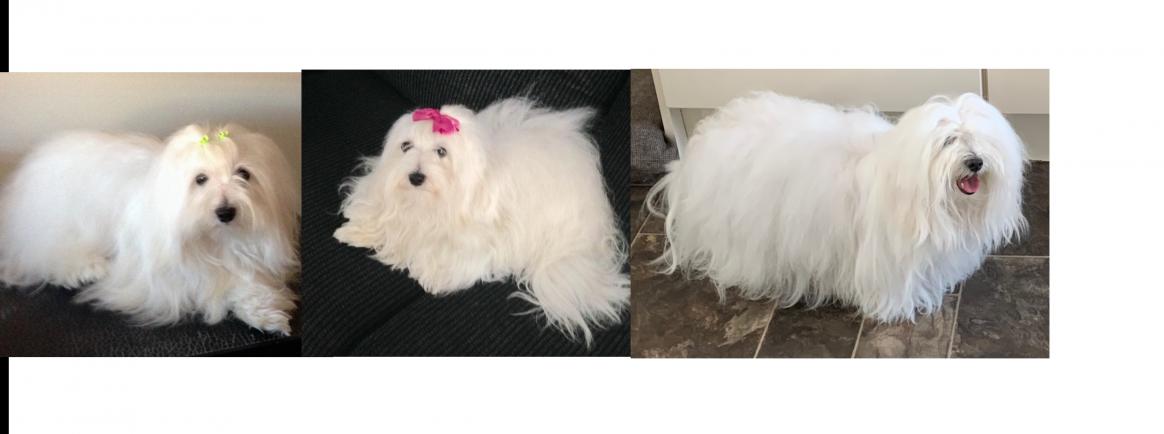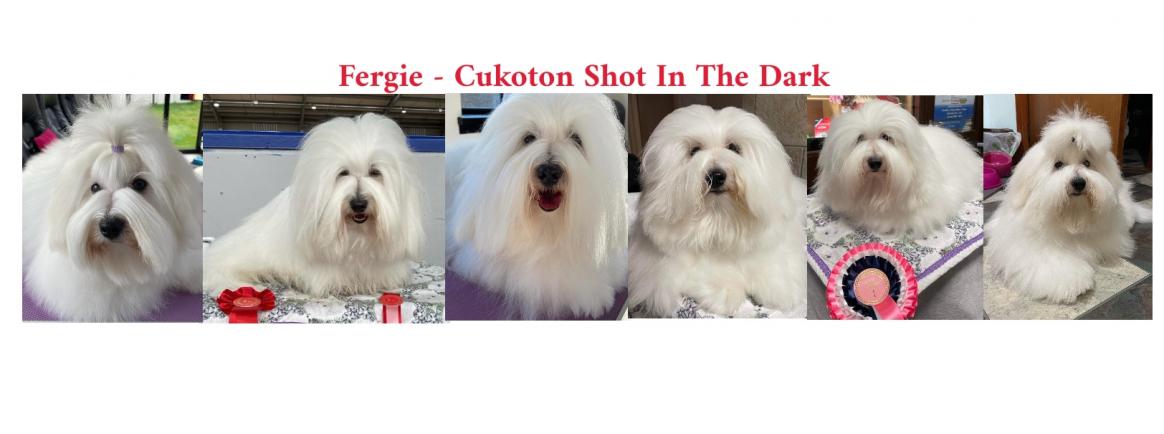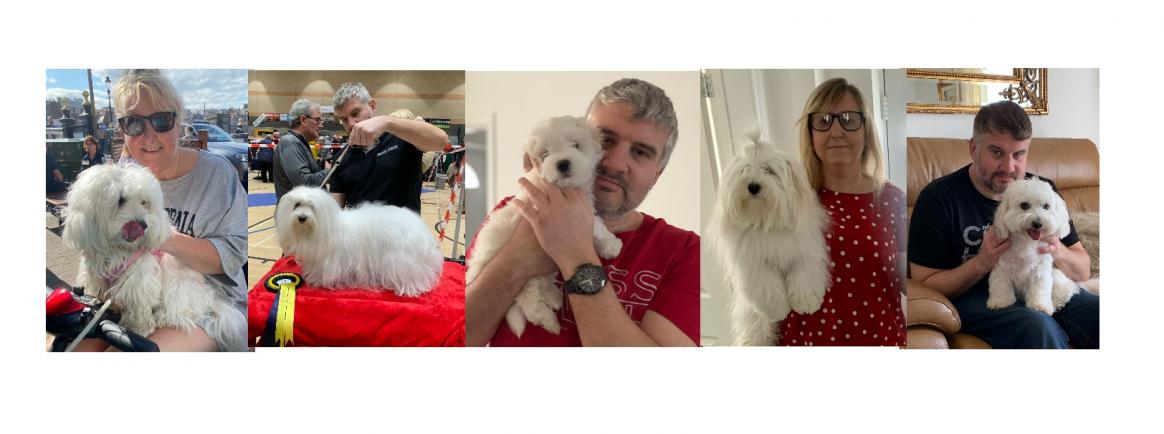GENERAL HEALTH PROBLEMS THAT HAVE BEEN RECORDED IN THE COTON DE TULEAR OVER A 30 YEAR PERIOD
USING BREEDERS, OWNERS, VETERINARY DATA, RESEARCH & CANINE ASSOCIATIONS
BLOOD LYMPH DISORDERS
Von Willebrand Disease Type 1
Dogs with vWD are prone to nose bleeds, bleeding from the gums, and prolonged bleeding during heat or after whelping. There may be prolonged bleeding from the umbilical cord at birth or when the pup sheds its baby teeth.
Symptoms include any of the following:
Prolonged or excessive bleeding after an injury.
Bleeding from the gums or nose.
Bloody urine.
Prolonged or excessive bleeding during or after surgery.
Blood in the stool.
Bruising of the skin.
Autoimmune Hemolytic Anaemia
Autoimmune hemolytic anemia (AIHA) is an immune system disease in which the body attacks and destroys its own red blood cells. In dogs with AIHA, red blood
Symptoms of Hemolytic Anemia in Dogs
Pale gums.
Weakness.
Lethargy.
Lack of willingness to exercise.
Fainting.
Dizziness.
Difficulty breathing, or breathing rapidly.
Disorientation.
Diabetes
Diabetes is most commonly caused by the body attacking & destroying its own insulin cells. It requires lifelong treatment, but well-managed diabetic dogs can live a long, happy life.
Symptoms
Excessive water drinking and increased urination.
Weight loss, even though there may be an increased appetite.
Decreased appetite.
Cloudy eyes (especially in dogs)
Chronic or recurring infections (including skin infections and urinary infections
CANCER TYPES
Melanoma
Malignant melanomas in dogs can be an aggressive cancer. We worry about both about the growth of the local tumor, as well as the potential for this tumor type to metastasize, or spread, to places like the local lymph nodes and lungs. Melanoma is the most common cancer found within the oral cavity in dogs
Symptoms of Malignant Melanoma in Dogs
Dark (black, brown, grey) lump or lesion on mouth, tongue, lips, or gums.
Facial swelling.
Bloody drool.
Foul breath.
Unable to eat.
Loose teeth.
Dropping food from the mouth.
Pancreatic
Altogether, the most common pancreatic cancer in dogs and cats are insulinomas, followed by adenocarcinomas." Of the endocrine tumors, there are 3 types: insulinomas, gastrinomas, and glucagonomas. All 3 are cancerous or malignant (i.e., invasive and prone to spread).
Symptoms of Pancreatic Cancer (Insulinoma) in Dogs
Collapse.
Incoordination.
Seizures.
Disorientation.
Muscle tremors.
Weakness.
Lethargy.
Depression.
Lymphoma
Lymphoma is a cancer of the lymphatic system. The lymphatic system is, amongst other things, involved in immunity and fighting
Symptoms of Lymphoma
Enlarged lymph nodes or swelling, especially in the neck, in back of the jaw, and behind the knees.
Loss of appetite.
Lethargy.
Weight loss.
Increased thirst and urination.
Fever.
Difficulty breathing.
CARDIAC DISORDERS
Mitral Valve insufficiency
Mitral valve disease (MVD) is a heart problem caused by a faulty heart valve. キ It's the most common type of heart disease in dogs
Symptoms
A heart murmur (detected by your vet)
Coughing. Especially after lying down or sleeping. Often worse at night.
Low energy and slowing down on walks.
Breathing quicker than usual/ breathlessness/ panting.
Weight loss.
Collapse/fainting.
Heart Murmur Pathologic
Pathologic heart murmurs can be caused by a structural problem within the heart (i.e., cardiac disease), or can be due to a problem that is 'extracardiac' (i.e., not caused by heart disease).
Symptoms Of Heart Murmur In Dogs
Symptoms of Histoplasmosis
Fever.
Cough.
Fatigue (extreme tiredness)
Chills.
Headache.
Chest pain.
Body aches.
Heart Murmur Innocent
An innocent or physiologic heart murmur is a heart murmur that has no impact on the dog's health. The murmur may first appear at 6-8 weeks of age, and a puppy with an innocent heart murmur will usually outgrow it by about 4-5 months of age. This type of murmur is benign.
Symptoms Of Heart Murmur In Dogs
Exercise intolerance.
Lethargy or weakness.
Panting, coughing, or difficulty breathing.
Pale gums or mucus.
Distended abdomen or bloated appearance.
Fainting or collapse.
Heart Disease
Dogs showing signs of heart disease may have a history of exercise intolerance, weakness, coughing, difficulty breathing, increased breathing rate, abdominal swelling (caused by fluid pooling in the abdomen), loss of consciousness due to lack of blood flow to the brain (fainting), a bluish tinge to skin
Heart problems tend to cause symptoms such as:
Coughing.
Breathlessness, heavy breathing or excessive panting.
Lethargy (low energy)
Exercise intolerance (slowing down on walks)
A heart murmur (which will be heard by your vet)
Collapse/fainting.
Weight loss.
Abdominal swelling.
Heart Failure
Congestive heart failure in dogs occurs when the heart is unable to pump an adequate amount of blood to the body, thus causing an increase in pressure and fluid that eventually leaks into the lungs and, less frequently, other major organs. ... CHF can be a slow-onset condition that develops over time.
Symptoms of Congestive Heart Failure in Dogs
Coughing.
Constant panting.
Struggling to breathe.
Breathing at a fast rate, especially when in a resting state.
Reluctance or refusal to exercise.
Getting tired more easily on walks or during play.
Fatigue.
Blue-tinged gums.
DENTAL DISORDERS
Underbite
A dog with an underbite may be at increased risk for various health problems. In cases of slight underbite due to a hereditary skeletal malocclusion, serious health issues are unlikely. As long as the dog is able to eat, drink and self-groom without issue, there is no cause for concern
Retained Puppy Teeth
Retained deciduous teeth are teeth that do not exfoliate once the permanent tooth erupts. This condition is seen most commonly in small breed dogs but can occur in medium to large breed dogs and cats. The most common retained deciduous tooth is the upper canine tooth, followed by the lower canine tooth
Symptoms of Retained Baby Teeth in Dogs
Food collections in the gap of the teeth.
Gingivitis.
Gingival hyperplasia refers to a medical conditon in which a dog's gum (gingival) tissue becomes inflamed and enlarged.
Overbite.
An overbite is a genetic, hereditary condition where a dog's lower jaw is significantly shorter than its upper jaw. ... Small overbites often correct themselves as the puppy matures, and brushing the dog's teeth regularly to prevent buildup can help keep the overbite from becoming more severe.
Periodontitis.
Your dog's mouth can be infected with a bacteria called periodontitis. Usually, you won't see any obvious signs or symptoms of this silent disease until it reaches its advanced stages, but gum disease can cause gum erosion, chronic pain, tooth loss and bone loss. Supporting structures of teeth can be weakened or lost.
Premature loss of adult teeth
The majority of the time when an adult pet loses a tooth it is due to significant periodontal disease. Often there are other teeth that are loose or diseased which can cause your pet discomfort. Periodontal disease is very common in pets and can significantly affect their quality of life.
Pus cavity forming under teeth.
Periodontal disease can cause the formation of an abscess, which is more common in dogs that have a tendency to bite or chew frequently (e.g., puppies that play and tug frequently). If left untreated, facial or mouth traumas, bacterial infections, and diabetes can all contribute to the formation of an abscess
Strenuous time eating food
Tartar .
Dogs develop plaque on their teeth when saliva, food particles and bacteria come together. If left untreated, this plaque combines with minerals in the mouth to become hard tartar that will eventually cause decay, gum disease and other ongoing oral health issues
Hypodentia (Missing Teeth)
Hypodontia, or missing teeth (Figure 9-16), can be genetic or can be the result of a disturbance during the early stages of tooth formation. Hypodontia usually presents no clinical problems for dogs and cats. Because dogs and cats do not experience mesial migration or drift, gaps in the dentition are less important.
EAR DISORDERS
Deafness
Deafness in dogs can either be a temporary, partial or total loss of hearing—due to a wax build-up in the ear canals—or permanent hearing loss due to a host of causes such as severe, untreated ear infections, congenital defects, old age and injuries. One or both ears may be affected.
symptoms of deafness in dogs?
Show a change in obedience or attentiveness.
Appear unresponsive to everyday sounds, such as the doorbell or vacuum.
Appear unresponsive to his/her name.
Fail to respond to familiar verbal commands.
Be difficult to rouse from sleep.
Be less active.
Bark excessively.
Chronic Ear infections
Chronic otitis is basically a long-lasting ear infection that can affect any dog, causing itchy, painful, smelly ears. Quite a few things can cause the disease — parasites, allergies, growths which is progressive and can lead to a rupturing of the eardrum or narrowing of the ear canal.
Scratching at the affected ear. Dark discharge. Odor. Redness and swelling of the ear canal.
ENDOCRINE DISORDERS
Cushings Disease
Cushing's disease (hyperadrenocorticism) is a serious health condition in dogs that occurs when the adrenal glands overproduce cortisol (cortisone) in the animal's body. Excess cortisol can put a dog at risk of several serious conditions and illnesses, from kidney damage to diabetes, and can be life-threatening.
Symptoms of Cushing's Disease
increased thirst.
increased urination.
increased appetite.
reduced activity.
excessive panting.
thin or fragile skin.
hair loss.
recurrent skin infections.
Hypothyroid
hypothyroidism is usually caused by one of two diseases: lymphocytic thyroiditis or idiopathic thyroid gland atrophy. The former disease is the most common cause of hypothyroidism and is thought to be an immune-mediated disease. ... These two causes of hypothyroidism account for more than 95% of the cases in dogs.
Here are some of the more common symptoms:
Lethargy.
Exercise intolerance.
Mental dullness.
Weight gain without a change in appetite.
Obesity.
Cold intolerance.
Changes in coat and skin, like increased shedding, hair thinning, and hair loss.
Thickening of the skin.
Thyroid
The thyroid gland is located in your dog's neck, where it produces the hormone thyroxine (T4), along with several other important thyroid hormones. These hormones play a large role in your dog's metabolism and can cause major problems when they are not produced at normal levels.
Symptoms
Lethargy.
Exercise intolerance.
Mental dullness.
Weight gain without a change in appetite.
Obesity.
Cold intolerance.
Changes in coat and skin, like increased shedding, hair thinning, and hair loss.
Thickening of the skin.
Endocrine disease, hormone imbalance
An endocrine disease is caused by an imbalance in hormone levels due to the body producing too much or too little of a specific hormone in the body. The health effects are variable, with some endocrine diseases proving fatal if left untreated – but others are more easily managed
Excessive thirst and appetite.
Excessive urination.
A pot belly.
Ongoing skin problems, thin skin and hair loss.
Poor tolerance of heat and excessive panting.
Lethargy.
EYE DISORDERS
Cataracts
A cataract is an abnormal cloudiness of the eye, caused by a change in the lens. キ Many different conditions can cause cataracts to develop
Symptoms
Changes in eye color or changes in pupil size or shape.
Cloudy pupils in one or both eyes.
Clumsiness.
Difficulty seeing in dimly lit areas.
Reluctance to climb or jump.
Rubbing or scratching of the eyes.
Dry EYE
Dry eye is a painful condition that develops when a dog is unable to produce a normal amount of tears. It usually affects both eyes, causing them to become dry and inflamed. Most commonly, dry eye is immune mediated, meaning it's caused by the immune system attacking the tear glands.
Symptoms of Dry Eye in Dogs
Redness around the eyes.
Mucous production (usually yellowish)
Brownish tint to the eye surface.
Excessive blinking.
Discharge of mucus, pus, or liquid from the eye.
Rubbing at the eyes and whining.
Loss of vision (severe circumstances)
Cherry Eye
“Cherry eye,” as it is commonly referred to, is a prolapsed gland of the nictitans. It occurs after a tear gland in a dog's third eyelid becomes inflamed. While it is usually not extremely painful, sometimes a dog will rub at it as if it were itchy.
Cherry Eye in Dogs
Oval swelling protruding from the edge of the third eyelid.
May occur in one or both eyes.
Epiphora (excessive tear production)
Inflammed conjunctiva.
Blepharospasm (excessive squinting)
Dry eye.
Retinal Dysplacia
The term retinal dysplasia really just means a malformation within the retina while dysplasia simply means that there is an abnormal or unusual development within a structure. RD can reduce the vision of your dog's eye and is usually a genetically inherited condition. This condition does not cause your pet any pain.
Symptoms of Retinal Dysplasia in Dogs
With retinal dysplasia in dogs, there are few noticeable symptoms apart from hesitancy to leap off things or seeming to be clumsy.
Your dog may bump into objects or may not be able to find things that you would expect him to such as a ball or a toy.
Reluctance to jump down off a ledge.
Glaucoma
Glaucoma (high pressure inside the eye) is a very painful condition that often causes blindness, especially if it's left untreated. There are two main types of glaucoma in dogs; primary and secondary. Glaucoma can't be cured, but most cases can be well managed with eye drops and other medication.
Glaucoma?
A hazy, cloudy or 'blue' appearance to the eye.
Redness of the white of the eye.
A dilated pupil that does not constrict when light is shone into the eye.
Signs of pain: sleeping more, a squinting or watering eye, being head shy or tilting the head.
Sudden blindness.
Progressive retinal Atrophy (PRA)
Progressive retinal atrophy. Atrophy means the partial or complete wasting of a body part. Progressive retinal atrophy (PRA), is a group of degenerative diseases that affect these photoreceptor cells. With this disease, the cells deteriorate over time, eventually leading to blindness in the affected dog.
Symptoms of Progressive Retinal Atrophy in Dogs
Progressive loss of night vision affecting both eyes is usually the first sign of the disease.
Day vision degeneration occurs over a period of time until total blindness results.
Eyes begin to have a cloudy look.
The eyes take on a grey colour and have a slight sheen.
Canine Multi-focal Retinopathy (CMR1 & CMR2)
Canine multifocal retinopathy 2 (CMR2) in an inherited eye disease caused by a mutation (c. 482G>A) in the Bestrophin 1 gene that disrupts protein function. Affected dogs typically present with multiple, discrete circular areas of retinal detachment around 15 weeks of age
Affected dogs typically present with multiple, discrete circular areas of retinal detachment around 15 weeks of age. Fluid accumulates under the detached retina resulting in gray, tan, orange or pink “blisters” in the eye. Progression of retinal changes is slow, ceases by 1 year of age and does not lead to blindness.
Pyogranulomatous Blepharitis
Pyogranulomatous blepharitis may be bilateral or unilateral, and clinical signs include exudative and ulcerative eyelid lesions, focal or diffuse eyelid swellings, conjunctival hyperemia, edema of the eyelid margins, and mucopurulent ocular discharge.
GASTROINTESTINAL PROBLEMS
Haemorrhagic gastroenteritis (HGE)
Acute hemorrhagic diarrhea syndrome (AHDS) (also known as hemorrhagic gastroenteritis [HGE]) is an acute (sudden) disorder of dogs characterized by vomiting and bloody diarrhea. ... AHDS can affect any breed, age, size, or gender of dog, but it is most common in small- and toy-breed dogs.
Symptoms of HGE include:
sudden onset of bloody diarrhoea.
vomiting.
lack of appetite.
stomach pain.
tiredness.
dehydration.
fever.
collapse.
Irritable Bowel
If your dog has intermittent bouts of diarrhoea/constipation or episodes of frequently passing small amounts of poo containing mucus, they may have IBS. Other signs of a flare-up can include bloating, abdominal pain, loss of appetite, vomiting and a general dwindling of their usual energy.
Bloat
Dogs can easily 'bloat' if they partake in any strenuous exercise too quickly after eating their meal. This may cause the stomach to swell and twist upon itself, causing blockages which can be life threatening to a dog if not treated quickly
Pancreatitis
Pancreatitis is inflammation of the pancreas. It causes vomiting, nausea and pain. The symptoms of pancreatitis vary depending how severely your dog is affected. Expert Vet Advice. Services: Improve the life of pets, Prevent illness,
The most common clinical signs include nausea, vomiting, fever, lethargy, abdominal pain, diarrhea, and decreased appetite. During an attack, dogs may take a 'praying position', with their rear end up in the air while their front legs and head are lowered onto the floor.
Anal Gland impaction
Anal sac disease is very common in dogs. The sacs frequently become impacted (plugged) usually due to inflammation of the ducts. The secretion within the impacted sacs will thicken and the sacs will become swollen and distended. ... The abscess will appear as a painful, red, hot swelling on one or both sides of the anus.
Symptoms you may see include: Scooting rear end along the ground. Excessive licking or biting at anal area or root of the tail. ... Brown or red discharges from anal area, often spotting the floor.
Food Intollerance
The signs include diarrhea, bloating, and abdominal discomfort after ingesting cow's or goat's milk. Dietary indiscretion. Dogs are famous for eating things they should not, including articles of clothing! Gluttony and garbage ingestion are frequent causes of adverse dietary reactions.
Vomiting or diarrhoea.
Flatulence.
Frequent scratching or hair loss.
Red, inflamed skin.
Chronic ear problems.
Poor growth in young dogs.
Coughing, wheezing and sneezing.
KIDNEY DISORDERS
Hyperuricosuria – (Bladder & kidney stones)
Hyperuricosuria means elevated levels of uric acid in the urine. This trait predisposes dogs to form stones in their bladders or sometimes kidneys. These stones often must be removed surgically and can be difficult to treat. Hyperuricosuria is inherited as a simple autosomal recessive trait.
Clinical signs of hyperuricosuria? Clinical signs of HUU can include difficulty urinating, frequent urination, blood in the urine, and urinating in unusual places. Some affected dogs show no clinical signs.
Primary Hyperoxaluria (PH)
(rare autosomal recessive disorder of glyoxlate which leads to progressive kidney failure and the crystals can accumuulate in bones, joints, cartlage, retina, & muscles)
What are symptoms of PH1?
Renal Failure
Incontinence urinary
LIVER DISORDERS
Portosystemic Shunts
Canine congenital portosystemic shunts (cPSS) are abnormal vascular communications between a tributary or branch of the portal vein and a systemic vein, allowing portal blood to bypass liver sinusoids and enter directly into the systemic venous circulation.
The most common clinical signs include stunted growth, poor muscle development, abnormal behaviors such as disorientation, staring into space, circling or head pressing, and seizures. Less common symptoms include drinking or urinating too much, vomiting, and diarrhea.
Liver Shunts
The portal vein is a large vein that collects blood from the gastrointestinal system, pancreas, and spleen and carries it into the liver, where toxins and other byproducts are removed. A liver shunt occurs when an abnormal connection persists or forms between the portal vein or one of its branches, and another vein, allowing blood to bypass, or shunt, around the liver.
In the majority of cases, a liver shunt is caused by a birth defect called a congenital portosystemic shunt. In some cases, multiple small shunts form because of severe liver disease such as cirrhosis. These are referred to as acquired portosystemic shunts.
The most common clinical signs include stunted growth, poor muscle development, abnormal behaviors such as disorientation, staring into space, circling or head pressing, and seizures. Less common symptoms include drinking or urinating too much, vomiting, and diarrhea.
Hepatic Lipidosis
Hepatic lipidosis, or fatty liver, is the condition of triglyceride accumulation in the liver which can be either physiologic or pathologic. ... In dogs, hepatic lipidosis primarily occurs in young, toy-breed dogs, with Yorkshire terriers, Chihuahuas, and Fox terriers appearing to be the most susceptible.
Symptoms
muscle weakness, ataxia, somnolence, convulsions, opisthotonus, and coma. These neurologic signs were attributed to cerebral neuronal necrosis due tohypoglycemia.
Hepatic Encephalopathy
Hepatic encephalopathy is a neurological condition that can occur in pets, more commonly in dogs, that already have liver disease. Neurological conditions affect the nervous system, which includes the brain, nerves, and spinal cord. The condition is potentially life threatening
the most obvious sign of Hepatic Encephalopathy is head pressing. If your dog is suffering from this disease, they may show the following signs, as well: Circling, pacing, running into walls. Lethargy, fatigue, drowsiness.
Cronic Active Hepatitis
Chronic hepatitis is a syndrome in dogs that can result from many different disease processes. It means that at some point there has been inflammation in the liver and possibly necrosis (cell death). Inflammation is due to infiltration of the liver with various white blood cells that are active in the immune system.
Symptoms of Chronic Hepatitis in Dogs
Sluggishness and lethargy.
Lack of appetite.
Weight loss.
Vomiting.
Seizures, metal dullness.
NEUROLOGICAL DISORDERS
Cerebellar Ataxia
Dogs that have exaggerated limb movements and head tremors might have an impairment in the cerebellum, the region of the brain responsible for fine motor movements. Cerebellar ataxia in dogs is usually due to congenital defects, inflammatory diseases, or brain tumors.
Weakness in one or more limbs.
Dragging the feet when walking.
Crossing the legs when walking.
Exaggerated limb movements.
Swayed gait.
Difficulty maintaining balance.
Stumbling and/or falling.
Wide-based stance.
Neonatal Ataxia – Bandera's Syndrome
Coordination is controlled by an area of the brain called the cerebellum. In Bandera's neonatal ataxia, this area of the brain never functions normally and the pups can never learn to walk normally. Pups with Bandera's syndrome never walk normally.
Neonatal Cerebellar Ataxia is a disorder that results in lack of movement coordination and only affects the Coton de Tulear and Havanese breeds.
Juvenile Ataxia
Weakness
Frequent tripping or stumbling
Uncoordinated gait
Broad-based stance
Difficulty getting up
Circling
Leaning or walking toward one side
Lethargy
Head tilted to one side
Abnormal eye movements (side to side, or up and down)
Abnormal eye position
Lack of appetite
Vomiting
Change in mental status
Epilepsy
Epilepsy is a chronic condition that causes repeated seizures (which may be described by terms such as 'fits' or 'funny turns'), and is the most common chronic (long-term) neurological disorder in dogs. It affects an estimated 0.6-0.7% of all dogs in the UK alone (around 1 in 130 dogs).
loss of voluntary control, often seen with convulsions (jerking or shaking movements and muscle twitching)
irregular attacks that start and finish very suddenly.
attacks that appear very similar each time and have a repetitive clinical pattern.
Seizure
There are many causes of seizures. Idiopathic epilepsy, the most common cause of seizures in the dog, is an inherited disorder, but its exact cause is unknown. Seizures can be caused by poisons, injury, illness and epilepsy. Some dogs will have an unexplained 'one off' seizure and never have another.
Symptoms can include collapsing, jerking, stiffening, muscle twitching, loss of consciousness, drooling, chomping, tongue chewing, or foaming at the mouth. Dogs can fall to the side and make paddling motions with their legs. They sometimes poop or pee during the seizure.
Strokes in older dogs
Strokes in dogs are relatively rare and can be difficult to spot.A stroke occurs when there is disruption to the blood flow to the brain.
Symptoms of strokes in dogs can include: Inability to walk or walking with an uncoordinated gait. Head tilt. Abnormal eye movements, side to side or rotary (nystagmus) ..
A stroke can also cause your pet to lose control of their body systems:
Vomiting.
Gasping.
Diarrhoea.
Loss of bladder control.
Heart arrhythmias.
Inability to breathe.
ORTHOPEDIC & MUSCLE DISORDER
Malignant Hyperthermia (MH)
Malignant Hyperthermia is an autosomal dominant genetic mutation that causes a dog to have dangerous physical reactions in response to specific triggers. The triggers includes exposure to certain drugs, most notably the inhaled anesthetics like halothane. Other triggers include the ingestion of food ingredients such as caffeine and hops and too much exercise. MH is also known as "canine stress syndrome" because the condition can become apparent when a dog is under stress or over-stimulated.
After experiencing one or more of the triggers, an affected dog can have extreme muscle contractions, increased metabolism, rapid heartbeat and elevated body temperature. The body produces too much carbon dioxide, and enters a hypermetabolic state. Muscles become rigid and stiff. Seizures are a possibility.
If a dog with the MH mutation undergoes anesthesia using halothane or other types of inhaled anesthesia, the results can be fatal. However, there are some forms of anesthesia that can be safely used to sedate dogs affected with MH. This is why it is important to identify dogs that have the mutation prior to scheduling surgical procedures. There is no cure for Malignant Hyperthermia, but dogs with this mutation can avoid stressful situations, intense exercise, and food and drugs that trigger symptoms.
Degenerative Myelopathy (EXON2)
Canine degenerative myelopathy (also known as chronic degenerative radiculomyelopathy) is a progressive disease of the spinal cord in older dogs. The disease has an insidious onset typically between 7 and 14 years of age. It begins with a loss of coordination (ataxia) in the hind limbs.
Affected dogs usually present clinical signs of disease in adulthood (at least 8 years of age) with gradual muscle wasting and loss of coordination
Patella Luxation
Patella luxation in dogs is a condition where the patella (knee cap) slips in and out of the groove. The patella can dislocate out of this groove, and therefore prevents the knee from extending properly. ... The condition will sometimes only affect one leg but can be seen in both knees in around 50% of dogs
Patella luxation is usually characterised by a 'skipping' or 'hopping' lameness, where the dog or cat will hold their leg up for several steps whilst running and then return to normal. When both legs are affected, you may see 'bunny hopping' or dragging of the legs for short periods as well as a stiff and awkward gait.
Legg-Calve-Perthes Disease
Legg-Calve-Perthes disease is also known as avascular or aseptic necrosis of the femoral head. This is a condition in which the head of the femur (the ‘ball’ in the ball-and-socket joint that forms the hip) spontaneously begins to degenerate. Over time, this degeneration will cause collapse of the hip and lead to arthritis.
symptoms of Legg-Calve-Perthes disease include:
Limping.
Pain or stiffness in the hip, groin, thigh or knee.
Limited range of motion of the hip joint.
Pain that worsens with activity and improves with rest.
Hip & Elbow Dysplacia
Hip and elbow dysplasia are one of the most common skeletal diseases in dogs. When it happens, the ball and socket of the hip or elbow joints has abnormal growth with insufficient coverage, which in turn makes the joint become loose and unstable. Long-term joint issues cause scar tissue around the joints.
Symptoms of elbow dysplasia
Limping or stiffness (usually worse after exercise and difficult to spot if both elbows are affected)
Less enthusiasm to go for walks or play.
Front paws pointing outwards and/or elbows held at a strange angle.
Swollen, puffy elbows (in severe cases)
Intervertebral Disc Disease
Intervertebral disc disease (IVDD) is the most common spinal disease in dogs and is also seen occasionally in cats. The most common spinal surgery performed in the dog is for intervertebral disc disease.
Intervertebral discs are fibrocartilaginous cushions between the vertebrae (except the first two cervical vertebrae) that allow movement, are supportive and act as shock absorbers. They consist of a fibrous outer rim, the annulus fibrosis, and a jelly like centre, the nucleus pulposus. Intervertebral disc degeneration results in diminished shock-absorbing capacity, and can ultimately lead to disc herniation and spinal cord compression.
The most common sign associated with intervertebral disc disease is pain localised to the back or neck. As nerve fibres flow from the brain to the muscle along the spinal cord, the clinical signs will refer to spinal cord dysfunction ‘down-stream’ of the injury, hence disc disease in the lower back can cause hind limb weakness, paralysis or urinary incontinence. Disc disease in the neck can cause weakness on all four limbs.
Apart from yelping, common signs of spinal pain are abnormal posture (e.g. hunched back with head down), shivering, panting, unwillingness to move, difficulty jumping, and going up and down stairs. In more severe cases, there may be difficulty walking, ranging from poor control of the hind limbs – either weakness or a ‘drunken sailor’ walk – to complete paralysis. Most severe cases have a paralysed bladder and may be unable to urinate and/or dribble urine. The most severe cases are paralysed, have lost bladder function and have lost the ability to feel painful sensations.
Spinal Deformity
Canine scoliosis can make your pet prone to pain, discomfort, and other conditions. When the spine gets bent and curved to one side, it compresses the spinal cord, creating neurological disorders, such as ataxia and paresis, which can weaken or eliminate muscle movement.
Signs of spinal cord disease as a result of spinal deformity can include:
pain.
wobbliness.
weakness in the back legs.
walking differently.
signs of muscle wastage in the back legs.
an abnormally shaped back.
Slipped Hocks
If the hock collapses forward, the puppy has a slipped hock. This potentially serious problem is far too commonly seen in the dog world. A slipped hock is when the joint itself bends the wrong direction; it hyper-extends or collapses forward. The weakness is in the tissue, not the bone.
Hock instability results in a sudden onset of lameness. There may be pain, swelling, and heat associated with the affected joint as well.
Osteoarthritis
Osteoarthritis (OA) is the most common form of arthritis in dogs, affecting approximately a quarter of the population. ... Majority of OA in dog occur secondarily to developmental orthopedic disease, such as cranial cruciate ligament disease, hip dysplasia, elbow dysplasia, OCD, patella(knee cap) dislocation.
Stiffness, lameness, limping, or difficulty getting up
Lethargy
Reluctance to run, jump, or play
Weight gain
Irritability or changes in behavior
Pain when petted or touched
Difficulty posturing to urinate or defecate, or having accidents in the house
Loss of muscle mass over the limbs and spine
Chondrodystrophy (excessive bowed legs)
There has been renewed interest in the subject of “abnormal” bone lengths, joints, angles between limbs, and related phenotypic variations from what I have called “the ancestral type.”We need to establish some definitions of terms before entering into a discussion of the subject. The “ancestral” phenotype in my arbitrary definition (which, however, is in line with the views of many or most professionals in animal science) is one that comes to mind when one thinks of the Jackal, Northern Wolf, and descendants of the extinct Pale-footed Wolf (such as sighthounds). The head is neither brachycephalic (pushed-in/shortened) nor exaggeratedly long and narrow (the dolichocephalic Borzoi, etc.), the leg length is such that the total height at withers is roughly twice the distance from elbow or chest to the ground, and limbs give an impression of being straight. Typical examples of ancestral types are the German Shepherd Dog, Saluki, various Spitz breeds, and many pariah breeds such as found in every corner of the world.
“Abnormal” phenotypes (and this will rouse the ire of many people who love their dogs and think of them as being “normal”) include breeds specifically bred to produce the characteristics that would be agreed on as being “faults” in the ancestral types. Think of the (“English”) Bulldog, Pekingese, Corgis, Dachshunds/Teckels, and others. I have long maintained that there is a genetic defect affecting primarily the hypophysis or pituitary gland, the “master gland” that so greatly influences the functions of the others as well as developmental processes.
Some variation within normal parameters results from the tremendous plasticity of the canine genotype, but here we are more interested in the departure from those limits of normality. Whatever the combinations of defective DNA nucleotide pairs (adenine-thymine, cytosine-guanine, etc.), and which glands or organs they initiate the changes in, many of the irregularities we are discussing here manifest themselves in the cartilage that is on the ends of bones and “bone centers.” Bone centers are those hard, mineralized portions of a growing bone that become enlarged (almost entirely on their long-axis surfaces) and fused together to form the eventual limb, and the cartilage between most bone centers is called a “growth plate”or physis. It gradually “calcifies” into bone tissue, thus uniting epiphysis (called a cap or head, usually) and metaphysis (shaft); it disappears during maturation. But if there is an abnormal coding of the nucleotide pairs, there is an abnormal calcification process, a “growth-plate disturbance.”
If one bone in a two-bone limb segment (such as the tibia/fibula or ulna/radius combinations) has more of a disturbance than the other, or if one end of the growing bone’s cartilage is disrupted during remodeling into bone tissue, there are unequal rates of growth and consequent bowing of that limb, with one part wanting to be longer than the other part does. In some dogs, disruption of normal cartilage-bone turnover at the ends can keep a single bone from growing in length, or if the disruption is laterally asymmetrical, the femur or humerus may also become slightly bowed. The pull of muscles and ligaments on different parts of such bones also has some effect on shape.
The general definition of “dysplasia” is poor or abnormal (dys-) shape or form (-plasia). Here, we are talking mostly about bone (osteo-) and cartilage (chondro-), and mostly about those tissues in joints. But just as the poet says, “no man is an island”, and genes that cause one thing can sometimes also cause something else. Some times it is a very obvious double influence, such as the gene that causes both deafness and white coat phenotypes in some breeds, or dwarfism and blood disorder in the Malamute. Most of the time, the influence of one gene or set of nucleotides is less obvious.
A couple more definitions would be helpful at this point, although you should realize that there are sometimes loose adherence to strict interpretation of such definitions:
chondrodysplasia: any growth plate (cartilage) disturbance resulting in canine dwarfism; in human pathology, it has a different meaning: enchondromatosis, a rare disorder marked by enlarged cartilage and tumors in joints.
chondrodystrophic: semantically similar to the above, but while –plasia refers to changeable shape, –trophic refers to growth. Thus, an abnormal cartilage growth pattern.
achondroplasia: that type which results in an individual with extremities shorter than the trunk. Examples in dogs include Basset Hound, Shih-Tsu?, and others mentioned elsewhere. In humans, it usually is marked by stubby hands, large head with sunken nasal bridge and, frequently, spinal column deformities.
CHONDRODYSTROPHY
Several breeds are of a body type we call chondrodystrophic, such as the Dachshund and Corgi. They have shorter legs (often bowed) and other dwarf characteristics in parts of the body. Frequently, these breeds also have a shorter vertebral arch that tends to produce a smaller vertebral canal. The vertebral body centers of ossification unite with the arch prematurely, with the same type of dystrophic bone growth pattern that causes shorter “long bones” in those breeds. See Chapter 16 in my orthopedics book for more illustrations and discussion on dwarfism. In some chondrodystrophoid breeds such as the Basset, a premature closure of the distal metaphyseal plate of the ulna (near the wrist) was thought by Herron, Grüll, Henschel, and von Hitz to cause fracture of an already closed anconeal process at the other end of that limb. Kasström and colleagues (and later, Wind) thought that this condition in certain dwarfed breeds “was the result of an abnormal pressure on the anconeal process… by the shortened ulna.” This anomaly in the anconeal process is not the same as the failure to unite, and obviously has a different genetic origin. Dr. Wind, the eminent expert on elbows, has observed that many cases of elbow dysplasias include subluxations associated with dwarfism.
There are many types of dwarfing related to slow endochondral bone formation (at the ends). Dwarfism can be proportionate or disproportionate, depending on the specific gene defects. Examples of the former include the pathological pituitary dwarfism of the German Shepherd Dog and the related Karelian Bear Dog. You can see GSD pituitary dwarfism in “The Total German Shepherd Dog” (Hoflin.com) and my website article about it. The non-pathologic selective miniaturization seen in Shar-Pei, Bull Terriers, Australian Shepherds, Poodles, and numerous other miniature and toy breeds and varieties probably should not be included in a discussion of dwarfism. Disproportionate dwarfs include Bulldogs, Basset Hounds, Pekingese, Dachshunds, Corgis, and many more that we see only in this form. While some would object to inclusion of their favorite breed here, it is still true that these are results of genetic defects. There are also “unnatural” occurrences of disproportionate dwarfism in breeds where you might not expect it: Malamutes, GSDs, and a few other “accidentals.” Of course, if one were to deliberately linebreed on these defects, a sub-population of short-legged representatives would be more common. That is what happened with a branch of the Parson Jack Russell Terrier, now known by several similar names in various show registries.
Some of these defects involve irregularities in the construction of the hypophysis (pituitary gland), as I have said; others may involve primary proteoglycans degradation that results in mucopolysaccharidoses, or other metabolic abnormalities. The various types of mucopolysaccharidoses involve enzyme deficiencies, incomplete fusion of the sacrum, incompletely developed vertebral end plates, short limbs, abnormal joint mobility, and other signs and deformities. Some osteochondrodysplasias (you now know how to break that word into segments, and what they mean) can be recognized at birth, others not until skeletal maturity approaches. The most common seen at birth is the achondroplasias of rabbits, mice, and humans, although some (erroneously?) apply that term to conditions in dogs, too. Some achondroplasia is from sporadic mutation, and most seem to be transmitted by a dominant gene. A few authorities have claimed that achondroplasia is not seen in the canine, but Aegerter and Kirkpatrick describe it as a genetic chondroblast (cartilage cell) disturbance in the epiphysis. Betts calls it “a symptom rather than a disease” and does not hesitate to apply the word to the “normal” condition seen in the Dachshund, Beagle, Basset Hound, French Bulldog, Pekingese, and similar breeds. He properly excludes pituitary dwarfs, miniaturized but proportionate breeds, Malamute dwarfism, and the dwarfism of Labs with retinal dysplasia. Various forms of chondrodysplasia affect Cocker Spaniels and German Shorthaired Pointers.
Miniature Poodles are occasionally found with a form of osteochondrodysplasia that has sometimes but properly erroneously referred to as “achondrodysplasia.” An increased collagen concentration and RNA content is often found in affected cartilage of such dwarfs, though DNA content is normal. There are differences in appearance between individuals because of modifier genes as well as environmental forces. Miniature Poodles with inherited epiphyseal chondrodysplasia are rhizomelic (it seems the shortness of their limbs comes primarily from the retardation of growth nearest the hips and shoulders) and often have ventrodorsal compression of the chest and enlarged joints. Occasionally a spontaneous mutation will produce symptoms similar to congenital spondyloepiphyseal dysplasia and “achondrodysplasia”, and variations on these are seen in many breeds, including multiple epiphyseal dysplasia in Miniature Poodles and Beagles.
Asynchronous (unequal) growth of the radius and ulna, that is, when these two bones’ growth rates are not coordinated, is found in non-dwarfs in a wide continuous “spectrum” of severity, often unnoticed by the average dog observer (and many a licensed dog-show judge!). Dwarfism is often an accompaniment to that asynchronous growth of the “double bones” in either front or rear limbs. Such dogs also have nearby limb segments shortened, such as the humerus or femur. The more extreme end of that range is considered by some to be “normal”in some breeds (to name some more: Corgis, Basset, Lhasa Apso, and Pekingese). However, elbow subluxation accompanied by pain has been reported in these dwarf breeds, and probably has a causal connection. While carpal valgus (turning out at the pasterns) and external rotation of the foot are “acceptable” within the descriptions of “breed type”, the occasional or perhaps frequent abnormalities of the ligaments and joints in the elbow that accompany this should be avoided or treated.
OTHER SIGNS
Chondrodysplasia in the most general sense is sometimes called a syndrome, other times part of a syndrome, the definition of that word being a collection of interconnected symptoms. Some dogs may have many, some a few, and others no readily observable symptoms. The clinical signs may be very mild, from almost undetectable bowing or shortening of the legs, to obvious skeletal deformity and the presence of several health problems. Chondrodysplasia Punctata is one name applied to a syndrome of multi-systemic disorders, and is so-called because of the “dots” of calcium phosphate deposits in the softer cartilage. It reminds me of the school of art made popular by Georges Seurat called “Pointillism.” This genetic-metabolic problem has various skeletal expressions. Depending on the particular variety, the mode of inheritance could be autosomal recessive or dominant, or X-chromosome-linked recessive or dominant, some with full penetrance, and some not.
Besides skeletal indications, there are eye disorders such as microphthalmia (smaller eyes than they should be), lens detachments, cataracts, glaucoma, retinal defects, and nystagmus (jerking or twitching of the eyeballs). Other occasionally reported symptoms are problems with internal organs, head and neck bone defects, partial deafness, alopecia, and luxated patellas (for more on this stifle problem, see my upcoming orthopedics book or some of the websites that carry my articles).
PREMATURE PHYSIS CLOSURE
Premature closure of growth plates happens because, in some etiology (manner), the ossification process of endochondral cartilage is disturbed. Overfeeding and mineral supplementation are definitely contributors, but genetic susceptibility has to be taken into account, as well — probably much more. Ettinger mentions that “the most common cause of premature growth interference has been direct trauma to the growth plate area”, though HOD and achondroplasia have also been reported in association with it. But he and his sources may have been giving too much credit/blame to physical or mechanical damage. The distal (furthest part) radius and ulna seem to be the most frequently involved sites for these disturbances.
Growth disturbances in the radius and ulna can be related to an outward twisting of the top of the ulna away from a good fit with the humeral condyles, enough so that subluxation or even luxation takes place. This lateral rotation may also exist independently, with no observed growth plate disruptions in those bones. The radius head can also dislocate, and both may occur at the same time, so there is quite a variety of changes possible, although the disorder is rare.
If the dislocations are not accompanied by (or secondary to) such asynchronous growth manifestations as seen in the ulna and/or radius, they are called congenital elbow dislocations. The premature closure of physes in ulna or radius, retained cartilage, chondrodysplasia or achondrodysplasia, and synostosis are separate problems. A condition of missing digits called ectrodactyly and another abnormality called cleft hand deformity have been seen in conjunction with congenital luxations and subluxations (also called arthrodysplasia) in the elbow.
ROOTS OF MANY OF THESE DEFECTS
Cholesterol has had a bad name among fad-diet promoters and people too lazy or busy to physically work off their calories. It is a product of the liver, necessary for the synthesis of Vitamin D as well as the assimilation of it, essential fatty acids, and Vitamins A, E, and K, but in sedentary people and those with genetic inability to metabolize it correctly, it can build up in the blood vessels and contribute to heart disease and stroke risk. At least some chondrodysplasias involve an error in the coding for biosynthesis of cholesterol. Since in the Havanese, a miniature Cuban breed, those who evidenced this dwarfism tested as having abnormal levels of several cholesterol-related sterols, a program of blood serum testing was undertaken. It was found that Havanese with normal straight legs had no such metabolic abnormality. in the body. These vitamins are needed for calcium utilization, bone development, and healthy eyes. The appearance of congenital defects, including osteochondrodysplasias, can often be blamed on inability to use these chemicals. Tracing a structural defect to its headwaters of a genetic defect expressed in a metabolic disorder along the route, is akin to finding the source of the Nile or Amazon.
PLEIOTROPIC DEFECTS
Pleiotropy is the phenomenon of having more than one phenotypic expression (often in grossly different manifestations) caused by the same gene — the same genetic defect. Alaskan Malamutes’ dwarfism is a pleiotropic genetic defect that shows up as both dwarfism of their particular type and a blood disorder. It has been fairly extensively studied, and while one dog may vary in appearance considerably from the other, the disorder is a simple autosomal (not sex-linked) recessive trait with complete penetrance. Asynchronous growth of the radius and ulna (one at a different rate or completion than the other, remember) is part of the deformity in this breed. The chondrodysplasia in this breed has at times been mistaken for the Vitamin D deficiency called rickets, but only the tubular bones are affected, other than retarded ossification of the lateral tarsal (cuboid) bone. The head, spine, and other bones are not stunted or changed, and body length is normal. The gene that causes this chondrodysplasia also creates a macrocytic hypochromic anemia; the discovery of this being indicative of the way carriers may be found. A third effect of this one gene, by the way, is a different ability to bind certain trace minerals in the liver.
On an excellent website calledhttp://www.rhosyngsd.com/, there was a good description and illustrations of dwarfism in the Havanese breed, and an ancillary discussion of dwarfism in the GSD, even though the site owner did not want to use that word for the condition. Havanese with dwarfism display ocular abnormalities as do a few other breeds. The front legs grow crooked or bowed, and all four legs are shortened, giving the height-to-length ratio an undesirably short aspect. Some Havanese breeders have reported that all cases of early-onset cataracts leading to premature blindness, and nearly all “other serious health problems reported in Havanese within the past few years, have been in dogs that also exhibit the symptoms [of chondrodysplasia].” In Havanese, it also has been noted that some dogs have such subtle signs — that they appear to have a straight leg on one side but not the other —asymmetric. Furthermore, one breeder asserts, such asymmetrical dogs, if they are also diagnosed as having cataracts, will have the cataract in the eye that is on the same side as the crooked leg! The Rhosyn website mentioned says, “To date, no Havanese with straight legs have been diagnosed with early-onset cataracts!” It must be added, however, that other long-time Havanese breeders deny any connection. It could well be merely coincidence. In fact, unless pleiotropy can be established, it would be best not to put much stock in the Rhosyn observation.
While on a judging assignment in Alaska in the early 1980s, I was presented with a Malamute from show lines, which had from an early age walked flat on its wrists. Because the forearm did not appear bowed I initially thought it might have been solely a case of carpal luxation syndrome—something that I had been seeing with increasing frequency in American German Shepherd Dogs. I lost track of the owner and did not see any radiographs or blood analysis. Later, after seeing more Malamute chondrodysplasia, I reconsidered my tentative “diagnosis.”I think now that it could possibly have been both disorders occurring concurrently in the same dog. Unfortunately my photographs of that dog were lost, but I later obtained pictures of other Malamutes, though without the extreme flat carpus.
A few other problems are similar, in that one gene (or gene pair, really) can cause ocular-skeletal dysplasia in Labrador Retrievers and possibly Samoyeds, for example. In this disorder, several defects in the eyeball, iris, and arteries serving the eyes are found in the same dogs that have short, thick leg bones (micromelia), prominent carpi (wrists) and elbows, and east-west stance in front. Hind legs usually are hyperextended (straight in stifle) yet still very short.
Great Pyrenees have their own style of micromelic dwarfism, too, as do a few other breeds. It is a simple recessive genetic trait, showing some similarities to Malamute dwarfism, and is marked by short curved ribs, underdeveloped rear limbs, all legs shortened, and abnormalities in the cartilage and bone of the vertebrae. Endochondral ossification disturbance can usually be seen on radiographs by 8 weeks. Often, ossification of the vertebral bodies, especially in the neck, is delayed right from the beginning, and visible on radiographs taken at 8 weeks of age. The metaphyses of the radius, ulna, and tibia are usually flared like the bell-bottom trousers of the hippies in the early 1970s or the sailors of a generation earlier. The condition does not automatically result in DJD (degenerative joint disease).
Norwegian Elkhound chondrodysplasia is similar to the other canine dwarfisms as well as to human spondylometaphyseal dysplasia; it is widespread in the breed, and may be associated with glycosuria (sugar in the blood), although in one study this was not found. Some curvature of the front legs may be noticed as early as 5 weeks of age, and all limbs are short in proportion to the body. It is also a simple recessive trait.
A disorder almost identical to the chondrodysplasia in two of the above-named breeds has recently been found in Akitas. Knowing how such reports usually lead to the identification of the same disease in other breeds (as has happened in panosteitis, “GSD myelopathy”, etc.), it is not very risky to predict that more will be added to this list in the future, though not at a high rate, given the very obvious nature of dwarfism and most breeders’ desires to sweep it under the rug or eliminate it.
On one website, there was a good description and illustrations of dwarfism in the Havanese breed, and an ancillary discussion of dwarfism in the GSD, even though the site owner did not want to use that word for the condition. Havanese with dwarfism display ocular abnormalities as do a few other breeds. the front legs to grow crooked or bowed, and all four legs are shortened, giving the height-to-length ratio an undesirably short aspect. Havanese breeders have reported that all cases of early-onset cataracts leading to premature blindness, and nearly all “other serious health problems reported in Havanese within the past few years, have been in dogs that also exhibit the symptoms of chondrodysplasia.” In Havanese, it also has been noted that some dogs have such subtle signs that they appear to have a straight leg on one side but not the other—asymmetric. Furthermore, that such asymmetrical dogs, if they are also diagnosed as having cataracts, will have the cataract in the eye that is on the same side as the crooked leg! The rhosyn website mentioned above says, “To date, no Havanese with straight legs have been diagnosed with early onset cataracts!” We must wait for more data and case histories before making definite statements about pleiotrophy, however.
Many other dysplasias considered as a subcategory under osteochondrodysplasias result from disturbed ossification along the periphery (outer edge) of the growth plates in various bones such as the ribs, vertebral processes, skull, and elsewhere.
ALD angular limb deformity
There are several types of angular limb deformities seen in dogs, usually identified when they are puppies. An angular limb deformity means the bones, usually of the front legs, do not grow as straight as they are expected to. In the lower front leg, the radius and ulna are the two parallel bones. If they do not grow at the same rate due to damage to a growth plate, the leg will begin to bow either inward or outward. In dachshunds, the tibia, the lower bone in the rear leg, can be affected.
The causes of angular limb deformities include trauma and genetic or congenital factors. The bowing of the leg due to the deformity is likely to lead to joint damage if the disorder is not recognized and corrected promptly.
Varus and Valgus Deformity in Dogs
A deformity where the foot rotates outward is called a valgus deformity. When the deformity rotates the foot inward, it is called a varus deformity. Symptoms include a change in the direction of the foot, a shortening of the leg, lameness, pain, swelling, and/or decreased range of motion of the affected joint(s).
This deformity can occur in one leg or in matching sets of legs, meaning both front legs or both back legs. Trauma is likely to affect one leg. Genetic or nutritional problems are likely to affect matching left and right legs. X-rays are critical in assessing for trauma, damage, and joint involvement. Quality X-rays including the elbows are essential.
Causes of Canine Angular Limb Deformity
The most commonly affected breeds are chondrodystrophic breeds. In other words, breeds with short limbs such as Pembroke and Cardigan Welsh corgis, dachshunds and basset hounds. But these deformities can also affect Shetland sheepdogs, collies, Newfoundlands and Rottweilers.
Badly healed fractures can also cause angular limb defects. Any time there is a fracture or trauma to a growth plate, or other evidence the foot is beginning to deviate inward or outward, prompt veterinary intervention is essential to minimize damage and arthritis.
In many cases, angular limb deformities are caused by trauma to the growth plate of the ulna, the longer bone in the lower front leg. This trauma causes the growth plate to close in the ulna before the growth plate in the radius, the parallel bone, closes. This means the ulna stops growing while the radius continues to grow. This causes the foot to begin to deviate outward, a valgus deformity. This can also be caused by a genetic or congenital defect, causing one or both growth plates to close prematurely.
This growth plate closure secondarily causes a malalignment of the elbow, called elbow incongruency. There is associated lameness; if this is not corrected with surgical intervention, will lead to significant elbow arthritis as the dog ages. In most cases, this specialized surgery should be performed by a surgical specialist, a board-certified surgeon.
REPRODUCTIVE & BIRTH PROBLEMS
Absorption/Abortion
The fetuses affected often have some sort of genetic abnormality that causes them to stop developing. Usually, only one or two puppies in a litter are absorbed. ... The fetus literally disappears from the uterus and is reabsorbed into the dog's body. It is not the same as a miscarriage, where the fetus is expelled.
Abnormal vaginal discharge (brown, green, black, or pus-colored) at any time during pregnancy, abdominal pain, and fever are all potential signs of miscarriage or infection. Additionally, some pets experiencing a miscarriage will begin to have contractions and deliver stillborn puppies.
Cryptorchid / Monorchid
Monorchidism is an all-too-common condition among male dogs. It refers to the defect in which one of the dog's testes remains undescended. ... Cryptorchid is derived from the Greek for “hid- den” “testicle.”
Cesarean Section
A caesarean section is the surgical removal of puppies from the uterus.
fever.
worsening pain.
increased vaginal bleeding.
increased redness at the incision site.
drainage or swelling of the surgical incision.
breast pain with redness or fever.
foul-smelling vaginal discharge.
pain when urinating.
Fading Puppy
Fading puppy syndrome is a term used to describe puppies that are apparently normal at birth but gradually fade and die within the first two weeks of life.
Symptoms of Early Death (Fading Puppy Syndrome) in Dogs
Low weight at birth.
Failure to gain weight.
Ignored by the mother.
Soft stools or diarrhea.
Continual crying.
Painful abdomen (puppy may make paddling movements)
Vomiting.
Salivation.
Puppy Congenital Defects
Commonly reported congenital and inherited defects in dogs include neurologic defects, eye defects, heart defects, skeletal muscle defects, failure of one or both testicles to descend into the scrotum (known as cryptorchidism), and hip and elbow abnormalities.
A variety of structural and functional defects have been described in animals. These birth defects are usually classified by the body system primarily affected, and many are discussed in this book under the appropriate body system section. Defective newborns have survived a disruptive event during embryonic or fetal development. Defective development may also cause embryonic loss, fetal death, mummification, abortion, stillbirth, a newborn not capable of living, or birth defects. When an abnormality is present at birth, it is called a congenital condition.
Susceptibility to environmental agents or genetic abnormalities varies with the stage of development and species, and decreases with fetal age. The fertilized egg is resistant to agents or factors that cause or increase the chances of a congenital defect (teratogens), but it is susceptible to genetic mutations and changes in the chromosomes. The embryo is highly susceptible to teratogens, but this susceptibility decreases with age as the critical developmental periods of various organs or organ systems are passed. The fetus becomes increasingly resistant to teratogens except for structures that develop late such as the cerebellum, palate, urinary system, and genitals.
The frequency of individual defects varies with the species, breed, geographic location, season, and other environmental factors. It is estimated to occur at a rate of 0.2 to 3.5% of all canine births. Commonly reported congenital and inherited defects in dogs include neurologic defects, eye defects, heart defects, skeletal muscle defects, failure of one or both testicles to descend into the scrotum (known as cryptorchidism), and hip and elbow abnormalities. Most congenital defects have no clearly established cause; others are caused by genetic or environmental factors or interaction between these factors.
Puppy Kidney Failure
Kidney failure is also referred to as renal failure, and can be caused by a number of diseases that can impact the kidneys and related organs. Healthy kidneys are supposed to eliminate toxins, regulate hydration, maintain a normal electrolyte balance and release hormones required to produce red blood cells.
Kidney failure technically happens when the kidneys can no longer perform their function efficiently, and in dogs there are two broad categories:
Acute renal failure
When kidney function suddenly decreases (within hours or days), this is known as acute renal failure. It is usually related to toxins or infections.
Chronic renal failure
If the loss of kidney function is gradual (over weeks, months or years), it’s referred to as chronic renal failure. It’s most commonly caused by degeneration associated with old age. All kidneys have a lifespan, but some dogs’ may deteriorate faster than others.
One clear difference between acute and chronic kidney failure is while acute kidney failure is likely reversible if treated early and aggressively, chronic kidney failure can only be managed.
Symptoms of kidney failure
Significant weight loss
Vomiting
Pale gums
Drunken behavior or uncoordinated movement such as stumbling
Breath that smells like chemicals
Significant decrease in appetite
Increase or decrease in water consumption
Increase or decrease in volume of urine
Ulcers in the mouth
Blood in urine
Lethargy
Intestinal seizures
RESPIRATORY DISORDERS
Elongated Soft Palate
Elongated soft palate is a very common abnormality found in brachycephalic dogs. Brachycephalic breeds include Boston terrier, boxer, bulldog, Pekingese, pug, Rottweiler, and shih tzu. ... Some common symptoms of elongated soft palate include breathing difficulties, snoring, stridor, snorting, gagging, etc.
Collapsed Trachea
Tracheal collapse is a form of tracheal obstruction caused by flaccidity and flattening of the cartilaginous rings which support the trachea. The condition is most often seen in toy breeds, especially the Yorkshire terrier, with the dogs' condition gradually worsening over time as the tracheal support deteriorates.
Signs of Tracheal Collapse in Dogs
Difficulty breathing.
Coughing when you pick your dog up or apply pressure to their neck.
Vomiting, gagging, or retching associated with the coughing.
Cyanotic (turning blue) episodes or bluish mucous membranes.
Wheezing.
SKIN DISORDERS
Skin Hypersensitivity Allergic Disorder
Skin allergies are also referred to as allergic dermatitis, and they are the most common types of allergies in dogs. Your pup may be allergic to any number of irritants that are causing him or her to itch, scratch, and become generally uncomfortable.
A skin allergy is an oversensitivity to items such as pollen, grass, house dust mites and/or certain foods.
Skin allergies (also known as allergic skin disease/atopic dermatitis) are one of the most common causes of itchy skin in dogs. If your dog has a skin allergy, this means that they are sensitive to something (or multiple things) that they come into regular contact with, for example:
House dust mites
Pollens, grass, trees, and moulds
Fleas
Food
Skin allergies are one of the most common causes of itchy skin in dogs.
Symptoms tend to include itchiness, redness, hair loss, and repeat skin/ear infections.
Skin allergy treatment is different for each dog, but often involves avoiding triggers, strict flea control, a special diet, and medication to stop the itch. Immunotherapy (desensitisation) can be used in some cases, but isn’t always successful.
Book an appointment with your vet if your dog has symptoms of a skin allergy.
Most dogs with allergic skin disease are allergic to more than one thing.
Symptoms
Skin allergies can develop in any dog, at any age, but are particularly common in certain breeds s
Symptoms usually include:
Itchy skin
Rashes and redness
Hair loss (alopecia)
Infections (skin and ear infections)
Overgrooming and saliva stained skin
Dark, thickened skin
Weepy eyes
Acute moist dermatitis (hot spots)
Atopic Dermatitis
Canine atopic dermatitis (allergic dermatitis, canine atopy) is an inherited predisposition to develop allergic symptoms following repeated exposure to some otherwise harmless substance, an “allergen”. ... Dogs may also rub their face on the carpet; ear flaps may become red and hot.
Sebaceaus Adenitis
The signs of sebaceous adenitis in long-haired dogs include: Areas of hair loss that are symmetrical from side to side on the body. Dull, brittle haircoat texture. ... In severe cases , itching and bacterial infection in the hair follicles which may progress to a generalized deep skin infection.
Hotspots
Canine hot spots are red, inflamed skin lesions also known as pyotraumatic dermatitis or acute moist dermatitis. ... Hot spots can be found anywhere on a dog's body, but the most common sites are head, legs, and hips. These painful, smelly sores may be very obvious or may be hidden beneath matted fur.
Demodectic Mange
Demodectic mange most often occurs when a dog has an immature immune system, allowing the mites to grow rapidly. As a result, this disease occurs primarily in dogs less than 12-18 months of age. In most cases, as a dog matures, the immune system also matures.
Symptoms of Demodectic Mange
In localized cases, it shows up as patches of hair loss and red, scaling skin.
In generalized cases, the entire body may be covered with redness, infections, scaling, swelling, and crusts. Often the dog loses most, if not all, hair.
Skin Cutaneous Cyst
Sebaceous cysts are swelling that forms underneath the skin of a dog. They form when the dog's skin pore or hair follicle is blocked by scar tissue, dirt, or debris. ... Sebaceous cysts can happen when the oily substance sebum (which keeps the hair healthy and shiny) clogs the skin pores and hair follicles.
Sebaceous cysts appear as a single raised bump that may seem white or slightly blue in color. If it bursts, it will ooze a grayish white, brownish, or cottage-cheese-like discharge. These cysts usually develop on the head, neck, torso, or upper legs. False cysts (those filled with blood) often look dark.
Yeast Infections
Swelling and warmth. Redness and swelling are the first signs of a yeast infection, but a dog's symptoms can progress to swelling, warmth, and pain in the infected area. Odor. Another common sign of yeast infection is a distinct smell, which will likely be your first indicator that your dog has this condition.
Signs Your Dog May Have a Yeast Infection
Skin redness or itching.
Sticky or yellow/green discharge.
Sores.
Greasy coat.
Hair loss.
Smelly skin.
Thickening skin.
Crusty, flaky skin.
Allergies
In the dog, the most common symptom associated with allergies is itching of the skin, either localized (in one area) or generalized (all over the body). In some cases, the symptoms involve the respiratory system, with coughing, sneezing, and/or wheezing. Sometimes, there may be runny discharge from the eyes or nose.
Alopecia
Alopecia is the partial or complete lack of hairs in areas where they are normally present. ... Or, the dog may be born with a normal coat ,and patchy or widespread hair loss occurs when the dog becomes a young adult. In acquired hair loss, the dog is born with a normal hair coat.
Histoplasmosis
Histoplasmosis is a fungal infection more commonly seen in cats, but it can also be found in dogs. The signs of histoplasmosis are variable and are often non-specific. Non-specific signs typically include mild fever, depression, weight loss, and loss of appetite. If the lungs are the primary site of infection, the dog may have labored breathing or a chronic cough.
Symptoms of Histoplasmosis
Fever.
Cough.
Fatigue (extreme tiredness)
Chills.
Headache.
Chest pain.
Body aches.
A - Z of General Canine Health Probems
ALL breeds of dogs DO suffer from health conditions, some breeds are more susceptible than others. The Coton's ancestor were apparently the Bichon Frise so I would think more health conditions linked to the Bichon Frise will possibly come to light as times goes on.
Some of the disorders listed below will not affect the Coton de Tulear but are listed for interest purposes
A-Z of General Canine Health problems
1. Aberrant cilia: eyelashes growing abnormally, such as rubbing against the eyeball (see #88).
2. Abnormal copper metabolism: (usually Bedlington terriers or Doberman pinschers) an inability to utilize and store copper properly, resulting in liver disease and other problems.
3. Abnormal dentition: abnormal placement, number and development of teeth.
4. Acanthosis nigricans: (usually dachshunds) a skin disease where the skin becomes thickened and dark, primarily affecting the axillae (armpits).
5. Achondroplasia: abnormal development of cartilage leading to dwarfism (seen aberrant in most breeds, but that's what makes a Basset hound and other achondroplastic breeds long and low).\
6. Acne: same thing as in humans, affects the muzzle and lip areas.
7. Acral lick dermatitis: a skin disease caused by an animal's licking a localized area excessively, especially on the legs and paws.
8. Acral mutilation: a progressive self-mutilation of the feet and legs. Also known as peripheral sensory neuropathy in pointing breeds because they are born without pain sensation.
9. Acute moist dermatitis: known as "hot spots," a localized area of a severely itchy, inflamed and oozing dermatitis exacerbated by the animal's intense licking and chewing at the spot.
9a. Addison's disease (hypoadrenocorticism): a disease characterized by inadequate secretion of cortisone from the adrenal glands. More common in Old English sheepdogs, standard poodles and bearded collies. (See #159a.)
10. Allergies: same as in humans. Dogs can be allergic to things they come in contact with, eat or inhale.
11. Amyloidosis: a condition where abnormal deposits of proteinaceous material called amyloid are laid down in tissues and impair their function. Common in Akitas and Chinese shar peis.
12. Anasarca: a condition where neonatal puppies have an abnormal accumulation of fluids in their tissues. Often seen in English bulldogs.
13. Anemia with chondrodysplasia: a condition of Alaskan malamutes where there is malformation and maldevelopment of cartilage and red blood cells. Also called stomatocytosis because of the mouth-like shape of red blood cells.
14. Anesthetic idiosyncracy: a condition where an individual has an abnormal response to commonly used anesthetics sometimes leading to death. Idiosyncratic means there is no good explanation or way to predict this.
15. Anomaly of third cervical vertebra: a malformation of one of the neck bones in the spinal column.
16. Anophthalmia: a condition where an animal is born without any eyes.
17. Aortic body tumors: a cancer that arises from a small organ at the base of the aorta, near the heart.
18. Apocrine gland tumor: a cancer arising from glands which secrete fluids (such as mammary glands).
19. Arteriovenous fistula: an abnormal connection that forms between arteries and veins.
20. Ataxia: (see #255, #288.) also called Bandera's syndrome a neurological disease in newborn Cotons
21. Atopic dermatitis: a skin disease caused by a dog's reaction to an inhalant allergy. (See #81.)
22. Atopy: an allergy caused from things dogs inhale.
23. Atresia of nasolacrimal puncta: a condition where the holes on the inside of the lower eyelids (puncta) are too small or closed so tears spill over the lid instead of draining to the nose.
24. Atrial septal defects: a malformation of the dividing wall between two chambers of the heart, usually resulting in a hole which then causes blood flow abnormalities.
25. Avulsion fractures: fractures of the bones caused by a piece being ripped away, usually because of its strong attachment to a ligament or tendon.
26. Basal cell tumor: a cancer arising from a type of skin cell.
27. Behavioral abnormalities: a whole range of abnormal behavior patterns, such as aggression, panic disorders, etc.
28. Bithoracic ectromelia: a condition where the front leg bones are very small or absent.
29. Blepharospasm: an abnormal tightening of the muscles around the eyes, which causes repetitive blinking.
30. Blindness: an inability to see due to a large variety of causes.
31. Bloat: a condition where a dog's stomach produces excessive gas and enlarges severely enough to cause death without immediate treatment. Usually associated with gastric torsion (see #131).
32. Blue eyes: an adverse reaction to certain vaccines containing canine hepatitis virus (adenovirus 1) which produces a bluish discoloration to the cornea.
33. Bullous pemphigoid: an autoimmune (i.e., the body attacking itself) disease associated with the formation of painful blisters.
34. Bundle branch block: an abnormality of the electrical conduction mechanism of the heart.
35. Bundle of His degeneration: a condition where a part of the electrical system of the heart deteriorates.
36. Calcinosis circumscripta: the development of lumps of hard calcium deposits in the skin.
37. Cancer, bladder: as in humans, cancer arising from the bladder.
37a. Cardiac valvular disease: weakness of heart valves producing heart murmurs and leading to cardiac failure. Prevalent in Cavalier King Charles spaniels.
38. Cardiomyopathy: a disease of weakened heart muscles. Common in giant breeds, boxers, Doberman pinschers.
39. Carotid body tumors: cancer arising from a small organ located on the carotid in the neck.
40. Carpal subluxation: a condition where the "wrist" bones are loose and out of alignment.
41. Castration responsive dermatosis: a skin condition characterized by loss of hair, thickened skin and inflammation which responds to castration (i.e., hormonal dependent).
42. Cataract: as in humans, a change in structure of the lens of the eye leading to cloudiness and usually to blindness.
43. Cataract with microphthalmia: a condition where a dog has cataracts along with abnormally small eyes.
43a. Cell-mediated immunodeficiency: a deficiency of t-lymphocyte function causing impaired immunity, chronic recurrent infections and stunted growth. Seen in Weimaraners and Dachshunds. (See #311b).
44. Cellulitis (folliculitis and furunculosis): inflammation and infection of the cells of the skin including the hair follicles and deeper structures.
45. Cerebellar cortical abiotrophy: malformation of the neurons in the cerebellum, a part of the brain.
46. Cerebellar degeneration: a condition where a part of the brain deteriorates.
47. Cerebellar and extrapyramidal abiotrophy: a condition where the neurons in the cerebellum part of the brain and parts of the spinal cord are malformed and eventually malfunction.
48. Cerebellar hypoplasia: a condition where the cerebellum, a part of the brain, is poorly formed (too small or absent) and doesn't function properly or at all.
49. Cerebrospinal demyelination: a condition where the neurons of the brain and spinal cord are malformed, lacking a specialized sheath, which causes malfunction.
50. Cervical disc disease: a degeneration or malformation of the cushioning discs between the spinal column bones (vertebrae) in the neck.
51. Cervical vertebral malformation or instability: a malformation of the vertebrae in the neck usually leading to nerve damage. Commonly seen in Doberman pinschers and causes a hackneyed gait (high stepping).
52. Choroidal hypoplasia: improper development of a part of the eye.
53. Ciliary dyskinesia: congenital trait in several breeds where all ciliated cells (those with hairs or moving appendages) are deformed and rigid. Also called immotile cilia syndrome and Kartagener's syndrome. Causes chronic pneumonia and sterility. Common in Bichon Frise and Doberman Pinschers.
54. Cleft lip: a condition where the two halves of the upper lip do not join together. Cleft palate and cleft lip are often seen together.
55. Cleft palate: a condition where the roof of the mouth is not closed and the inside of the nose opens into the mouth.
56. Coliform enteritis: an inflammation of the bowel tract caused by a certain group of bacteria.
57. Collapsed trachea: a condition where the cartilage rings that make up the trachea are malformed and tend to collapse easily.
58. Collie eye anomaly: a condition of collie dogs where the narrow shape of the head causes the eyes to be malformed.
59. Coloboma: an abnormal development of the eye, usually seen in collies, which can lead to blindness (see #203).
60. Colobomas with aphakia: same as above but with congenital absence of the lens.
61. Color mutant alopecia: a condition where certain colored areas of a dog's skin grows less or no fur. Commonly seen in Yorkshire terriers, blue Doberman Pinschers and fawn Irish setters.
61a. Combined immunodeficiency: a severe combined deficiency of cell-mediated immunity (T-cell function) and low levels of serum immunoglobulins (IgA, IgG, and variably IgM). Affected puppies usually die from viral infections by 12-16 weeks of age. Seen in Basset hounds. (See 343a, 168, 169, 170.)
61b. Complement deficiency: a deficiency in serum levels of the third component of complement which impairs neutrophil function and causes recurrent infections. Seen in Brittany spaniel
62. Canine Multi Focal Retinopathy (CRM2) : an autosomal recessive eye disorder, it causes lesions to form on the retina which alters the apperance of the eye but not effecting sight usually seen in puppies, however total blindness usually results in older age.
(CMR) is a hereditary disease. Most often affected dog breeds are: Great Pyrenees, English Mastiffs, Bullmastiffs, Coton de Tulear and related breeds.
CMR symptoms are very similar to Best macular dystrophy disease (BMD) in humans. BMD and CMR are retinal disorders caused by mutation in VMD2 gene (Vitelliform Macular Dystrophy 2 Gene). VMD2 gene is coding a protein bestrophin which is responsible for right forming of pigment epithelium in retina. Mutations in VMAD2 gene cause pigment epithelium athrophy which is leading to serious damage of sight.
62a Conjunctivitis: an inflammation of the conjunctival membrane of the eye.
63. Conus septal defect: a developmental abnormality of the right ventricle of the heart.
64. Copper storage abnormalityin liver: (see #2.)
65. Corneal dystrophy: an abnormality of the cornea usually characterized by shallow pits in the surface.
66. Corneal leukomas: an abnormal accumulation of a white material in or on the cornea.
67. Corneal ulcer, superficial: an erosion of the outer membrane and outer surface of the cornea.
68. Craniomandibular osteopathy: an abnormal development of the bones of the face and the jaw. Seen in West Highland white and Cairn terriers, among other breeds.
69. Cranioschisis: abnormal development of the skull characterized by openings between or in the bones.
70. Cryptorchidism: a condition where one testicle does not descend into the scrotal sac.
71. Cushing's disease (hyperadrenocorticism): a disease characterized by an excess secretion of cortisosteroids from the adrenal glands. (See #156.)
72. Cutaneous asthenia: a condition where the skin lacks its normal strength, elasticity and sensation. Also called Ehlers- Danlos syndrome. Seen in several breeds, including English springer spaniels and boxers. (See #94a.)
72a. Cutaneous vasculopathy: a disease of autosomal recessive inheritance in which young puppies exhibit foot-pad swelling and depigmentation, with crusting and ulceration of the tips of ears and tail. Seen in German shepherd dogs.
73. Cyclic neutropenia: a condition characterized by periodic lowering of neutrophils, a type of white blood cell. Commonly seen in grey collies.
74. Cystic ovaries: a condition where the ovarian follicles become cyctic (fluid filled) leading to hormonal imbalances and other problems.
75. Cystinuria: an abnormal excretion of a substance (cystine) in the urine.
76. Cystitis and cystic calculi: infection of the bladder which often leads to formation of abnormal mineral deposits (bladder stones).
77. Dacrocystitis: inflammation of a tear sac.
78. Deafness: an inability to hear, due to many different causes.
79. Deformed tail: a congenital condition where the tail is malformed.
80. Demodicosis: a kind of skin disease (mange) caused by microscopic Demodex canis mites living within the skin layers and producing an immunodeficiency syndrome.
81. Dermatitis, atopic: inflammation and subsequent infection of the skin due to atopy (see #21 and #22).
82. Dermatomyositis: a disease affecting the skin and muscles, usually in collies or Shetland sheepdogs.
83. Dermoid cyst: a small growth composed of skin-like structures.
84. Dermoid sinus: similar to a dermoid cyst but usually larger. Seen in Rhodesian ridgebacks.
85. Diabetes mellitus: a metabolic disease caused by insulin deficiency and characterized by the inability to utilize sugars normally.
85a. Digital hyperkeratosis: a condition of Irish terrier puppies that causes marked thickening of the foot pads. Affected feet crack, become infected and painful.
86. Discoid lupus erythematosus: a form of autoimmune disease affecting the skin.
87. Dislocation of shoulder: a condition where the bones of the shoulder joint are out of proper position.
88. Distichiasis: abnormally growing eyelashes.
89. Dwarfism: an abnormality of the normal growth pattern resulting in an undersized individual.
90. Dystocia: complications of the birth process (difficult birth).
91. Eclampsia: convulsions usually seen around the time of parturition (whelping).
92. Ectodermal defects: any of a multitude of abnormalities arising from maldevelopment of the fetal ectoderm (e.g., skin, nervous system, eyes).
93. Ectopic ureters: the ureters (tubes leading from the kidneys to the bladder) do not empty into the bladder in the normal location.
94. Ectropion: an abnormal rolling out of the eyelids.
94a. Ehlers-Danlos syndrome: a connective tissue disease characterized by loose, hyperextensible and very fragile skin that tears easily (see #72).
95. Elbow dysplasia: an abnormal development of the elbow joint.
96. Elbow joint malformation: (see #95.)
97. Elbow subluxation: a condition where the elbow joint is loose and out of alignment.
98. Elongated soft palate: the soft palate is abnormally long and causes breathing disorders.
98a. Encephalitis: an inflammatory condition of the brain causing signs of central nervous system dysfunction and epilepsy (seizures). A unique form of encephalitis is prevalent in the pug breed and is called "Pug Dog Encephalitis." (See #109.)
99. Endocardial fibroelastosis: an abnormal condition of scarring of the muscles of the heart.
100. Endometritis: inflammation of the internal layer of the uterus.
101. Enlarged foramen magnum: a condition in which the opening in the skull where the vertebral column begins is too large.
102. Enostosis: a bony growth within the hollow part of a bone.
103. Entropion: an abnormal rolling in of the eyelid.
104. Eosinophilic granuloma: an allergic reactive syndrome characterized by the plaque-like accumulation of eosinophils, a type of white blood cell.
105. Eosinophilic panosteitis: a painful inflammatory bone disease of young, rapidly growing dogs, often characterized by increased eosinophils in the blood. (See #231.)
106. Epidermal dysplasia: abnormal development of the outer layer of the skin. Common in West Highland white terriers and begins in puppy-hood. (See #331.)
107. Epidermoid cyst: a small growth consisting of tissues of the outer layer of the skin (see #274.)
108. Epidermolysis bullosa: an abnormal looseness to the skin characterized by large, deep, blister-like lesions.
109. Epilepsy: a disease characterized by convulsions (seizures) and/or disturbances of consciousness.
110. Epiphora: abnormal draining of tears often due to overproduction.
111. Epiphyseal dysplasia: abnormal development of the epiphysis, a part of the long bones.
112. Esophageal achalasia: a functional stricture or spasm of the muscles of the esophagus where it joins the stomach.
113. Esophageal dilatation: an abnormally large and usually flaccid esophagus.
114. Eversion of nictitating membrane: a condition where the third eyelid is protruding.
115. Eye abnormality: any of a number of problems with the eye.
116. Facial fold dermatitis: an infection of the facial skin caused by unusual or excessive skin folds (seen in dogs such as the Pekingese or Chinese shar pei).
117. Facial nerve paralysis: a decrease or cessation of function of the facial nerve leading to a drooping of the affected side of the face.
118. Factor I deficiency or hypofibrinogenemia: a rare deficiency of a clotting factor (fibrinogen), which causes excessive bleeding.
119. Factor II deficiency or hypoprothrombinemia: a rare deficiency of prothrombin, a clotting factor needed to control bleeding.
120. Factor VII deficiency: a mild bleeding disease primarily of beagle dogs.
121. Factor VIII deficiency or hemophilia A: the most common severe inherited clotting disorder of humans and nonhuman animals. In-hereited as a sex-linked recessive trait (carried by females and manifested in males). Affects most dog breeds.
122. Factor IX deficiency or hemophilia B: same as hemophilia A, but more rare and involves a different clotting factor. Affects about 20 dog breeds.
123. Factor X deficiency: a rare clotting disorder primarily of American cocker spaniels. An autosomal trait (affects both sexes).
124. Factor XI deficiency: a rare clotting disorder of several dog breeds. Protracted bleeding from surgical procedures is a feature. Affects both sexes.
124a. Factor XII deficiency: a clotting factor deficiency that rarely produces clinical signs. Seen in toy and standard poodles and occasionally in other breeds. Usually diagnosed incidentally during blood testing for potential bleeding disorder.
124b. Familial amaurotic idiocy: deposits of fatty pigments in the brain produce loss of vision, stuppor, and seizures. Seen in English setters, Germn short-haired pointers, and Australian cattle dogs. (See #177, 193a, 214.)
124c. Fanconi syndrome: a kidney tubular dysfunction of Basenjis which leads to glycosuria (see #268).
125. Fibrosarcoma: a cancer arising from certain types of fibrous cells.
126. Fibrous histiocytoma: a type of fibrous tumor arising from cells called histiocytes.
127. Flank sucking: a behavioral problem common in Doberman Pinschers and exhibited as a continually wet patch on the flank (from sucking the skin).
128. Fold dermatitis: an inflammation of skin folds especially in dogs with loose skin (e.g., Chinese Shar Pei).
129. Folliculitis: an infection of the hair follicles.
129a. Fragmented coronoid process: osteochondrosis of the elbow joint. (See #221a.)
130. Furunculosis: an infection of the deeper structures of the skin.
131. Gastric torsion: a condition where the stomach twists, thereby impeding input and output. (See #31.)
132. Generalized myopathy: a condition affecting all the muscles of the body which produces weakness.
133. Genu valgum: malformation of the knee joint ("knock-kneed").
134. Gingival hyperplasia: overgrowth of the gum tissues.
135. Glaucoma: abnormally high pressure in the eye.
136. Globoid cell leukodystrophy: abnormal development and/or function of certain types of white globoid cells in the brain. (See #193a.)
137. Glycogen storage disease: a syndrome characterized by an inability to store and utilize carbohydrates. (See #193a.)
138. Goiter: a swelling of the thyroid gland.
138a. Granulocyte dysfunctin or adhesion defect: an impairment of neutrophil function or adhesion which causes chronic recurring infections, stunted growth and secondary increase in immune globulins (hypergammaglobulinemia). See in Irish setters and Doberman pinschers.
139. Granulomatous colitis: a type of chronic inflammation of the colon characterized by reactive tissue growths.
140. Granulomatous sebaceous adenitis: a disease of sebaceous (sweat) skin glands characterized by reactive tissue growth and autoimmune destruction of the sebaceous glands. Hair loss occurs and is poorly responsive to treatment. Common in standard poodles, Akitas, samoyed and vizslas.
141. Hair follicle tumors: abnormal growths of the hair follicles.
142. Hairlessness: also called alopecia or loss of hair. Can be a normal pattern for breeds like the Mexican hairless dog.
143. Hanging tongue: a syndrome where the tongue does not retract into the mouth properly, due to neurologic or anatomic defects. Commonly seen in Cavalier King Charles spaniels.
143a. Hemangiosarcoma: a cancer of blood vessels involving liver, spleen or skin.
144. Hemeralopia: inability to see in daylight.
144a. Hemorrhagic gastroenteritis: an acute disorder characterized by bloody diarrhea, elevated hematocrit and shock. Common in miniature schnauzers.
145. Hemivertebra: a particular kind of malformation of the vertebra where only half of the structure is formed.
146. Hemolytic anemia: anemia caused by the destruction of the red blood cells by an autoimmune process. Particularly common in cocker spaniels and Old English sheepdogs, as well as several other breeds.
147. Hemophilia A: a blood clotting disorder due to deficiency of coagulation factor VIII (this is the most common type of hemophilia in dogs). (See #121.)
148. Hemophilia B: a blood clotting disorder due to lack of coagulation factor IX. (See #122.)
149. Hepatic portosystemic shunt or arteriovenous fistula: a malformation of blood vessels in the liver or an abnormal communication between the arteries and veins in the liver.
149a. Hepatic lipidosis: an abnormal accumulation of lipids in the liver which leads to liver failure. Common in miniature schnauzers and Shetland sheepdogs.
149b. Hereditary nephritis: also called "Samoyed hereditary glomerulopathy," a sex-linked disease of young males. Affected dogs have renal glomerular disease which rapidly progresses to kidney failure and death. Female carriers have abnormal glomerular basement membrane as well, but usually remain healthy until later life when renal failure may occur.
149c. Hereditary spinal muscular atrophy: an autosomal dominant degenerative disease of motor neurons characterized by weakness and muscle atrophy with a typical gait, and progressing to dangling of the head and a drooping, paralyzed tail. Severely affected dogs become paralyzed and die by 3-4 months of age. Seen in Brittany spaniels.
149d. Hepatocerebellar degeneration: a syndrome of progressive cerebellar and hepatic disease of 6-8 week old Bernese mountain dogs with lesions of cerebellar abiotrophy and coexistant hepatic lesions. Autosomal recessive inheritance.
150. Hermaphroditism: a syndrome where the individual has anatomical features of both sexes.
151. Heterochromia, iris: the presence of different colors in the same or both irises.
152. Hip dysplasia: a developmental malformation or subluxation of the hip joints.
153. Histiocytoma: a tumor composed of certain skin tissue cells (i.e., histiocytes).
154. Hydrocephalus: a condition where there is an abnormal accumulation of fluid in the ventricles of the brain.
155. Hygroma: a fluid-filled sac usually occurring on the elbows of large breed dogs such as the Great Dane or Irish wolfhound.
156. Hyperadrenocorticism or Cushing's disease: a disease where the adrenal glands are overactive. (See #71.)
157. Hypercholesterolemia: a disease where the animal has too much cholesterol in the blood system. Commonly associated with hypothyroidism.
158. Hypertrophic osteodystrophy: a condition of rapidly growing giant breeds where there is an abnormal inflammation of bones with pain and development of excessive bony growths.
159. Hypertrophy of nictitans gland: a condition where the gland of the third eyelid is abnormally large.
159a. Hypoadrenocorticism: a disease where autoimmune or other causes of destruction of the adrenal glands produces a deficiency of corticosteroids. (See #9a.)
160. Hypoglycemia: a syndrome where the animal has an abnormally low blood glucose.
160a. Hypomyelinogenesis: failure of the nervous system to form myelin, seen at birth.
161. Hypopigmentation, lips and nose: a condition where an animal lacks pigment (color) in areas where it is usually present. (See #328.)
162. Hypoplasia of dens: a condition where part of the second vetebra fails to develop fully and leads to instability.
163. Hypoplasia of larynx: a condition where the larynx (cartilage of the "voice box") fails to develop fully.
164. Hypoplasia of trachea: a trachea that fails to develop fully.
165. Hyposomatotropism: failure of the body growth hormones (somatomedins) to develop fully. Also known as growth hormone- responsive dermatosis. Common in Pomeranians.
166. Hypothyroidism: a common endocrine disease where the body produces an abnormally low amount of thyroid hormones. An autoimmune destruction of the thyroid gland which affects more than 50 dog breeds. (See #192, #312.)
167. Hypotrichosis: a condition where there is an abnormally small amount of hair growth.
168. Immunoglobulin A deficiency: a condition where levels of secretory immune globulins are low. Common in Chinese shar peis and beagles. (See #187.)
169. Immunoglobulin G deficiency: a condition where circulating antibody levels are low. Produces immune deficiency and susceptibility to infections.
170. Immunoglobulin M deficiency: a condition where antibodies produced in early stages of an immune response are low, producing susceptibility to infection. Seen in Doberman pinschers.
171. Inguinal hernia: a break in the muscular layer of the body wall occurring at the inguinal canal (where the back leg meets the body).
172. Intestinal malabsorption: a disease where the intestinal tract does not absorb nutrients properly. Also known as protein- losing enteropathy as a consequence of inflammatory bowel disease. In Irish setters there is also a wheat-sensitive enteropathy.
173. Intervertebral disc disease: a disease where the discs between the vertebra are abnormal and prone to rupture and misplacement.
174. Intussusception: a serious condition where the intestinal tract telescopes in on itself.
175. Iris atrophy: a condition where the iris (the colored part of the eye) shrinks and becomes non-functional.
176. Iris heterochromia: a condition where one iris is a different color from the other or has more than one color to it.
177. Juvenile amaurotic idiocy: a syndrome characterized by early onset blindness and low mental capacity.
178. Juvenile cellulitis: an inflammation of cells (usually skin cells) occurring in the young animal.
179. Keratitis sicca: a condition where one or both eyes do not produce a normal amount or type of tears.
180. Keratoacanthoma: a small growth, usually on the face, filled with keratin material.
181. Keratoconjunctivitis sicca: (see #179.)
182. Kidney aplasia, unilateral: a developmental abnormality where one kidney fails to develop. Also called renal agenesis.
183. Kinked tail: a developmental abnormality where the tail has a pronounced kink.
184. Lacrimal duct atresia: a condition where the duct draining tears from the eye is too small or not formed.
185. Legg-Perthes disease: a disease where the blood vessels feeding the femoral head (top part of the thigh bone) shrink, leading to starvation and death of the femoral head (the ball of the ball-and-socket joint of the hip). Also called Legg-Calve'- Perthes disease.
186. Lens luxation: a condition where the lens in the eye is displaced into an abnormal position.
187. Linear IgA dermatosis: a type of skin disease resulting from an abnormality of the secretory immune system. Common in Chinese shar peis.
188. Lip fold dermatitis: a skin infection caused by redundant skin folds around the mouth.
188a. Lipidosis: a form of lysosomal storage disease where lipids accumulate in nerves. Called GM-1 gangliosidosis in Portuguese water dogs. (See #193a.)
189. Lissencephaly: an abnormal brain development where the surface lacks gyri (the grooves).
190. Lung torsion: a condition where one or more lung lobes twist upon themselves.
191. Lymphedema: a disorder where valvular blockage of lymph flow or twisted lymphatic ducts causes an accumulation of fluid to swell tissues with edema.
192. Lymphocytic thyroiditis: an autoimmune disease causing inflammation and destruction of the thyroid gland, which becomes infiltrated with lymphocytes (white blood cells) and leads to hypothyroidism. This is the most common endocrine disease of the dog and has an inherited predisposition (see #166, #312).
193. Lymphosarcoma: a cancerous condition involving the lymphatic system. One of the more common canine cancers.
193a. Lysosomal storage diseases: a group of progressive multifocal neurologic disorders caused by specific enzyme deficiencies leading to death of nerve cells and accumulation of their respective enzyme substrates in cells. (See #299a.)
194. Malabsorption syndrome: (see #172.)
195. Malocclusion: a condition where the teeth do not meet properly.
196. Mastocytoma: a rare cancer developing from a type of tissue cell known as a mast cell.
197. Melanoma: a rare cancer developing from the type of skin cell which produces pigment (melanin).
198. Metabolic bone disease: any of a number of diseases affecting the bones due to an abnormality of metabolism.
199. Microphthalmia: a condition where one or both eyes are too small.
200. Missing teeth: a condition where there are too few teeth.
201. Mitral valve defects: a group of abnormalities of the mitral valve of the heart.
202. Mononephrosis: a condition where only one kidney is present.
203. Multiple colobomas: a developmental abnormality of the structures of the eye.
204. Multiple epiphyseal dysplasia: a condition where many of the long bones develop abnormally due to changes in the growth plates.
204a. Muscular dystrophy: a congenital and often inherited form of generalized muscle dysfunction which causes signs such as poor growth, weakness, abnormal gait, difficulty eating and swallowing, and muscle atrophy. Affected animals have serious health problems and may die or be euthanize. Inheritance is sex-linked in Golden retrievers, Irish terriers, Samoyeds, and Belgian shepherds.
205. Muzzle pyoderma: an infectious skin disease on the muzzle of an animal.
206. Myasthenia gravis: a syndrome characterized by muscle fatigue due to an autoimmune disease which produces chemical abnormalities of the muscles and nerves. An enlarged esophagus called megaesophagus can result and causes regurgitation of food.
206a. Narcolepsy: a neurological disorder characterized by falling asleep suddenly (collapse) which can occur during periods of activity and last for varying lengths of time. Seen in Doberman Pinschers and Labrador retrievers.
207. Narrow palpebral fissure: an abnormally small opening between the upper and lower eyelids.
208. Nasal pyoderma: a skin infection of the nose.
209. Nasal solar dermatitis: a skin disease of the nose and muzzle which is greatly affected by exposure to sunlight. Common in collies.
210. Nasolacrimal puncta atresia: (see #23.)
211. Necrotizing myelopathy: a condition where the spinal cord gradually dies.
212. Necrotizing panotitis: a severe infection of the ear and surrounding tissues.
213. Neuromuscular atrophy: a condition where the muscles waste away due to lack of proper nerve supply.
214. Neuronal ceroid lipofuscinosis: a congenital disease where fatty pigments are deposited in the brain and cause brain dysfunction. (See #193a.)
215. Neurotropic osteopathy: a disease of the bones due to abnormalities of the nerves.
216. Nodular panniculitis: a skin disease characterized by nodules of inflammation under the skin.
217. Oligodendroglioma: a cancer arising from a type of cell found in the brain and spinal cord.
218. Oligodontia: an abnormally small number of teeth.
219. Open fontanel: a condition where the suture lines between bones of the skull do not fuse together properly.
220. Optic nerve hypoplasia: a condition where the optic nerve going from the eye to the brain is too small.
221. Osteochondritis dissecans: a specific form of inflammation of the cartilage of certain joints which causes arthritis. (See #221a.)
221a. Osteochondrosis: a group of developmental diseases resulting in abnormal formulation of joint cartilage. Commonly involves the shoulder, stifle, hock or elbow. (See #221.)
222. Osteodystrophy: any of a number of diseases involving the development of the bones.
223. Osteogenesis imperfecta: imperfect development of the structure and/or mineralisation of the bones.
224. Osteopetrosis: a condition where the bones are abnormally dense and hard.
225. Osteosarcoma: a cancer arising from the cells of the bones.
226. Otitis externa: an infection of the external structures of the ear.
227. Otocephalic syndrome: a developmental abnormality where the animal lacks a lower jaw, and the ears meet below the face.
228. Overshot jaw: a condition where the upper jaw is too long for the lower jaw.
229. Pancreatic insufficiency: a condition where the pancreas does not produce the proper enzymes for digesting food.
230. Pannus: an immunologic eye disease characterized by abnormal growth of tissue over the cornea.
231. Panosteitis: (see #105.)
232. Parosteitis: inflammation of tissue around a bone.
233. Parotitis: inflammation of the parotid salivary gland. Also called parotiditis.
234. Partial alopecia: some loss of the normal hair-coat.
235. Patella luxation: a condition where the knee caps slide in and out of place.
236. Patent ductus arteriosus: failure of the vessel remnant joining the aorta and pulmonary artery in fetal life to close properly at birth, thereby shunting blood away from the lungs.
237. Pattern alopecia or baldness: hair loss occurring in certain patterns. Common in dachshunds.
238. Pemphigus erythematosus: one of many skin diseases caused by an autoimmune mechanism.
239. Pemphigus foliaceous: another skin disease caused by autoimmune destruction of tissues.
240. Perianal adenoma: a cancer arising from a cell of a gland found near the anus.
241. Perianal fistulas: a condition characterized by abnormal communications from deeper tissues to the skin surrounding the anus.
242. Perianal gland tumor: (see #240.)
243. Persistent right aortic arch: a developmental abnormality where one of the fetal blood vessels near the heart does not atrophy as it should.
244. Persistent hyaloid artery: as #243, however, involving a blood vessel inside the eye.
245. Persistent pupillary membrane: a developmental abnormality where the membrane forming the iris does not form properly.
245a. Phosphofructokinase deficiency: a deficiency of a specific red blood cell enzyme in English Springer spaniels. Causes chronic anemia, exercise-induced acute hemolytic crises and enlarged spleen.
246. Pigmentary keratitis: an inflammatory condition of the cornea characterized by abnormal pigmentation.
247. Pituitary dwarfism: a developmental abnormality resulting in an undersized animal due to a defective pituitary gland.
248. Pituitary tumor: a cancer arising from the pituitary gland.
249. Platelet disorder: a group of abnormalities of small blood cells necessary to control bleeding. (See #311.)
250. Pododermatitis: a skin infection of the paws.
251. Polyostotic fibrous dysplasia: a type of bone disease where the bones are composed of improper fibrous tissues.
252. Polyradiculoneuritis: an acute inflammatory disease of several groups of nerves causing fever.
253. Posterior retinal atrophy: a deterioration of the part of the eye which translates light to electric impulses (the retina). Produces night blindness. (See #256.)
254. Primary peripheral retinal dystrophy: a certain type of developmental disease affecting the retina.
255. Progressive ataxia: a condition where the animal's sense of coordination deteriorates.
256. Progressive retinal atrophy: a disease where the retina slowly deteriorates, producing night blindness.
257. Prolapsed rectum: a condition where the inside of the rectum protrudes outside the anus.
258. Prolapsed uterus: a condition where the uterus protrudes into the vaginal canal or through the vaginal opening.
259. Pseudohermaphrodism (pseudohermaphroditism): a condition where the animal has the gonads of one sex but the appearance is ambiguous or is of the opposite sex.
260. Pulmonic stenosis: a condition where one of the valves of the heart does not open properly.
261. Pyloric stenosis: a condition where the opening leading from the stomach does not function properly.
262. Pyometra: an bacterial infection of the uterus where it fills with pus.
263. Pyruvate kinase deficiency: a deficiency of a specific red blood cell enzyme. Most commonly seen in Basenjis; also in beagles and Cairn terriers.
264. Quadriplegia with amblyopia: a syndrome characterized by weakness of all four limbs, as well as of vision.
264a. Rage syndrome: sudden unprovoked aggression of serious nature. Seen in English Springer spaniels. (See #27.)
265. Recessive retinal dysplasia: a developmental disorder resulting in an abnormal retina, carried by a recessive gene.
266. Renal cortical hypoplasia: a condition where the cortex of the kidney(s) develops incompletely.
266a. Renal dysplasia: a condition where the kidneys form abnormally. Renal failure develops with protein loss in urine.
267. Renal hypoplasia: a condition where the kidney(s) do not develop completely.
268. Renal tubular dysfunction: a condition where the tubules of the kidneys (the filtering structures) do not function properly. (See #124b.) In basenjis, glycosuria develops and is called Fanconi syndrome.
269. Retinal detachment: where the retina is unattached to the back of the eye.
270. Retinal dysplasia: a condition where the retina is malformed.
271. Schnauzer comedo syndrome: a skin disease of schnauzers where the skin forms comedones ("blackheads").
272. Scotty cramp: a condition fround in Scottish terriers where the animal has periodic, generalized cramping of the muscles.
273. Screw tail: a birth defect where the tail is twisted tightly on itself.
273a. Sebaceous adenitis: (see #140.)
274. Sebaceous cyst: a small mass in the skin with a secretory lining and filled with a yellow waxy-like material (see #107).
275. Sebaceous gland tumor: a tumor arising from sebaceous glands of the skin.
276. Seborrhea: a skin disease with excess scaling of the skin and often an excess of sebum (oil-like substance) and odor.
277. Sertoli cell tumor: a tumor of the testicles which secretes estrogen and causes feminisation.
278. Short skull: a skull that is abnormally short for the breed in question.
279. Short spine: a spine that is abnormally short for the breed in question.
280. Short tail: a tail that is abnormally short for the breed in question.
281. Shoulder abnormalities: a group of disorders of the shoulder joint due to malformation or subluxation.
282. Shoulder dysplasia: a looseness of the shoulder joint.
283. Silica uroliths: stones which are composed primarily from silicone that form in the bladder.
284. Sinoatrial syncope: a condition where the electrical impulses of the heart are abnormal and the animal has episodes of syncope (fainting).
285. Skin disorders: any of a number of abnormalities of the skin.
286. Skin neoplasms: any number of tumors arising from cells of the skin.
287. Spina bifida: a developmental abnormality where some vertebra are malformed thereby exposing the spinal cord.
288. Spinal cord demyelination (ataxia): an abnormality of the nervous tissue of the spinal cord leading to in-coordination.
289. Spinal dysraphism: a developmental abnormality where the spinal cord does not form completely.
290. Spinal osteochondrosis: a specific type of developmental abnormality of the vertebrae.
291. Splenic torsion: a condition where the spleen twists upon itself.
292. Spondylolisthesis (Wobbler's syndrome): a condition where the vertebrae of the neck slip out of joint and are malformed causing progressive incoordination of the rear legs. Commonly seen in Doberman Pinschers. (See #51.)
293. Spondylosis: a malformation of the vertebrae.
294. Squamous cell carcinoma: a cancer arising from the squamous type of skin cell.
295. Stenotic nares: a condition where the openings of the nose (nares) are too small.
296. Sterile pyogranuloma syndrome: a disease of the deeper layers of the skin characterized by formation of abnormal tissues, with no infectious organisms involved.
297. Sternal callus: a thickened, hairless area forming on the chest of an animal.
298. Stockard's paralysis: a degeneration of parts of the spinal cord causing paralysis.
299. Stomach torsion: (see #131.)
299a. Storage disease: (see #193a and #188a.)
300. Subaortic stenosis: a tightening of the outflow opening for blood to go from the heart into the aorta. Common in golden retrievers and Newfoundlands.
301. Subcorneal pustular dermatosis: a skin inflammation occurring between certain layers of the skin.
302. Subcutaneous cysts: small fluid-filled masses accumulating under the skin.
303. Subvalvular aortic stenosis: as #300, but the tightening occurs below the aortic valve.
304. Swimmer puppies: a developmental defect which causes a flattening of the body so that newborn pups are unable to place their feet under them for proper locomotion. Also Bandera's syndrome a neurological disease in newborn Cotons
304a. Syncope: a brief period of fainting or collapse.
305. Syringomyelia: developmental abnormalities causing cavities within the spinal cord, probably just an effect of #289. Common in Rhodesian Ridgebacks.
306. Systemic lupus erythematosus: an autoimmune disease where antibodies form against the nuclear protein of cells. Characterized by skin lesions as well as other organ dysfunctions and blood abnormalities.
307. Tail abnormalities: any number of problems associated with the tail.
308. Tail fold dermatitis: a skin infection caused by abnormal tissue folds around the tail.
309. Teeth abnormalities: any number of problems of the teeth.
310. Tetralogy of Fallot: a specific four-way developmental abnormality of the structures of the heart and associated great vessels.
311. Thrombocytopathy: a functional abnormality of small blood cells (thrombocytes or platelets) which are needed to control bleeding. (See #249.)
311a. Thrombocytopenia: a reduced number of platelets in the blood which causes pinpoint hemorrhages in the skin and mucosa. Often accompanies #146 as an autoimmune syndrome called Evans syndrome. (See #249.)
311b. Thymic atrophy: a deficiency of cell-mediated immunity expressed by decreased T-cell function and low levels of growth hormone. Occurs in Weimaraners. (See #165.)
312. Thyroiditis: an autoimmune inflammatory disease of the thyroid gland. (See #166 and 192.)
313. Tracheal collapse: (see #57.)
314. Trembling of the hindquarters: a condition where the rear legs tremble due to muscle weakness or other pathologies.
315. Type II muscle fiber deficiency: a deficiency in form and/or function of a specific type of muscle fiber.
316. Ulcerative colitis: an autoimmune inflammation of the lining of the colon characterized by formation of ulcers.
317. Ulcerative keratitis: an inflammation of the cornea characterized by the formation of ulcers.
318. Umbilical hernia: a break in the abdominal muscle wall at the point where the umbilical cord enters the body.
319. Undershot jaw: a condition where the lower jaw is too long for the upper jaw.
320. Ununited anconeal process: a developmental abnormality of one of the bones of the elbow joint causing pain. (See #221a.)
321. Uric acid calculi: bladder stones which are formed primarily from urates. Common in Dalmatians.
322. Uric acid excretion abnormalities: an abnormality in the process of the excretion of the uric acid formed during metabolism. Common in Dalmatians.
323. Uterine eclampsia: (see #91.)
324. Uterine inertia, primary: a condition where the uterus does not have the muscular strength to proceed with the birth process, and not due to any acquired problems (e.g., malnutrition).
325. Vaginal hyperplasia: an overgrowth of tissues of the vagina.
326. Vasculitis: an inflammatory condition of the blood vessels.
327. Ventricular septal defect: an abnormality (usually a hole) in the wall between the two chambers of the heart.
327a. Vitamin B12-responsive malabsorption: a disease of young Giant schnauzers in which there is selective inability to absorb vitamin B12 from the bowel. Affected puppies have chronic non-regenerative anemia, low white blood cell counts, low serum vitamin B12, metabolites (methylmalonic acid) in the urine, and failure to thrive.
328. Vitiligo: a lack of pigment in the skin (called vitiligo in man and hypopigmentation in nonhuman animals). Common in rottweilers, Doberman pinschers, Old English sheepdogs and dachshunds. (See #161.)
329. Vogt-Koyanagi-Harada-like syndrome: an autoimmune disease common in Akitas and the "sled" dog breeds where the eyes, blood and other tissues are progressively destroyed leading to blindness and death.
330. von Willebrand's disease: a type of bleeding disorder caused by defective blood platelet function. Occurs in 59 dog breeds but most often in Doberman pinschers. An autosomal trait affecting both sexes.
331. Westie armadillo syndrome: a condition of West Highland white terriers where the skin becomes very thickened. Related to atopic (inhalant) allergies. (See #106.)
331a. White dog shaker syndrome: a disorder mainly of white dogs having muscular tremors over entire body, in coordination and rapid eye movements. Episodes occur with stress or excitement.
332. Wobbler's syndrome: (see #51 and #292.)
333. Zinc deficiency: can be caused by dietary problems, but also from an inability to utilize and store zinc properly. Seen as a lethal problem called acrodermatitis in bull terriers.
334. Zinc-responsive dermatosis: a condition where the skin is abnormal (scaly, hair loss, etc.) but which responds to the administration of zinc in the diet.
Sources
A-Z of Dog diseases and common health problems by Dick Lane
www.medicinenet.com
www.pethealthnetwork.com






















